Metamorphic Conditions of Neotethyan Meliatic Accretionary Wedge Estimated by Thermodynamic Modelling and Geothermobarometry (Inner Western Carpathians)
Abstract
1. Introduction
2. Geological Setting and Review of Previous Results
2.1. Lithostratigraphy and Geochemistry
2.2. Metamorphism
2.3. Tectonic Evolution and Geochronology
3. Methods
4. Results
4.1. Petrography of Metamorphic Rocks
4.1.1. Bôrka Unit
4.1.2. Jaklovce Unit
4.1.3. Meliata Unit
4.1.4. Silica Nappe Hanging Wall Mélange
4.2. Mineral Chemistry
4.2.1. Clinopyroxene
4.2.2. Garnet
4.2.3. Amphiboles
4.2.4. White Mica
4.2.5. Chlorite
4.2.6. Carbonates
4.2.7. Feldspars
4.3. PXRD Analysis
4.4. P–T Estimates
4.4.1. Bôrka Unit
Marbles
4.4.2. Jaklovce Unit
Metabasites
Metaradiolarites
4.4.3. Meliata Unit
Flysch Metasediments
Metaradiolarites
PXRD Results in P–T Estimates
4.4.4. Silica Nappe Hanging Wall Mélange
5. Discussion
5.1. The Bôrka Unit
5.2. The Jaklovce Unit
5.3. The Meliata Unit
6. Conclusions
Supplementary Materials
Author Contributions
Funding
Acknowledgments
Conflicts of Interest
References
- Platt, J.P. Exhumation of high-pressure rocks: A review of concepts and processes. Terra Nova 1993, 5, 119–133. [Google Scholar] [CrossRef]
- Cloos, M. Lithospheric buoyancy and collisional orogenesis: Subduction of oceanic plateaus, continental margins, island arcs, spreading ridges, and seamounts. Geol. Soc. Am. Bull. 1993, 105, 715. [Google Scholar] [CrossRef]
- Ernst, W.G. Metamorphic zonations on presumably subducted lithospheric plates from Japan, California and the Alps. Contrib. Mineral. Petrol. 1971, 34, 43–59. [Google Scholar] [CrossRef]
- Liou, J.G.; Zhang, R.Y.; Eide, E.A.; Maruyama, S.; Ernst, W.G. Metamorphism and tectonics of high-P and ultrahigh-P belts in the Dabie–Sulu region, eastern central China. In Tectonic Evolution of Asia; Yin, A., Harrison, T.M., Eds.; Cambridge University Press: Cambridge, UK, 1996; pp. 300–343. [Google Scholar]
- Rumble, D.; Liou, J.G.; Jahn, B.M. Continental crust subduction and UHP metamorphism. In The Crust, Treatise on Geochemistry; Rudnick, R.L., Holland, H.D., Turekian, K.K., Eds.; Elsevier: Amsterdam, The Netherlands, 2003; Volume 3, pp. 293–320. [Google Scholar]
- Zheng, Y.-F.; Zhou, J.-B.; Wu, Y.-B.; Xie, Z. Low-Grade Metamorphic Rocks in the Dabie-Sulu Orogenic Belt: A Passive-Margin Accretionary Wedge Deformed during Continent Subduction. Int. Geol. Rev. 2005, 47, 851–871. [Google Scholar] [CrossRef]
- López-Carmona, A.; Abati, J.; Reche, J. Petrologic modeling of chloritoid–glaucophane schists from the NW Iberian Massif. Gondwana Res. 2010, 17, 377–391. [Google Scholar] [CrossRef]
- Kozur, H.; Mock, R. Zum Alter und zur tektonischen Stellung der Meliata-Serie des Slowakischen Karstes. Geol. Zbor. Geol. Carpath. 1973, 24, 365–374. [Google Scholar]
- Kozur, H.; Mock, R. Erster Nachweis von Jura in der Meliata-Einheit der südlichen Westkarpaten. Geol. Paläont. Mitt. Innsbruck 1985, 13, 223–238. [Google Scholar]
- Kozur, H. The evolution of the Meliata-Hallstatt ocean and its significance for the early evolution of the Eastern Alps and Western Carpathians. Palaeogeogr. Palaeocl. 1991, 87, 109–135. [Google Scholar] [CrossRef]
- Mock, R.; Sýkora, M.; Aubrecht, R.; Ožvoldová, L.; Kronome, B.; Reichwalder, P.; Jablonský, J. Petrology and petrography of the Meliaticum near the Meliata and Jaklovce villages, Slovakia. Slovak Geol. Mag. 1998, 4, 223–260. [Google Scholar]
- Faryad, S.W.; Spišiak, J.; Horváth, P.; Hovorka, D.; Dianiška, I.; Jósza, S. Petrological and geochemical features of the Meliata mafic rocks from the sutured Triassic oceanic basin, Western Carpathians. Ofioliti 2005, 30, 27–35. [Google Scholar]
- Kovács, S.; Sudar, M.; Karamata, S.; Haas, J.; Peró, C.; Grădinaru, E.; Gawlick, H.-J.; Gaetani, M.; Mello, J.; Polák, M. Triassic environments in the Circum-Pannonian Region related to the initial Neotethyan rifting stage. In Variscan and Alpine terranes of the Circum-Pannonian Region; Vozár, J., Ebner, F., Vozárová, A., Haas, J., Kovács, S., Sudar, M., Bielik, M., Péró, C., Eds.; Geological Institute SAS: Bratislava, Slovakia, 2010; pp. 87–156. [Google Scholar]
- Putiš, M.; Koppa, M.; Snárska, B.; Koller, F.; Uher, P. The blueschist-associated perovskite-andradite-bearing serpentinized harzburgite from Dobšiná (the Meliata Unit), Slovakia. J. Geosci. 2012, 57, 221–240. [Google Scholar] [CrossRef]
- Putiš, M.; Danišík, M.; Ružička, P.; Schmiedt, I. Constraining exhumation pathway in an accretionary wedge by (U-Th)/He thermochronology—Case study on Meliatic nappes in the Western Carpathians. J. Geodyn. 2014, 81, 80–90. [Google Scholar] [CrossRef]
- Gawlick, H.-J.; Missoni, S. Middle Triassic radiolarite pebbles in the Middle Jurassic Hallstatt Mélange of the Eastern Alps: Implications for Triassic–Jurassic geodynamic and paleogeographic reconstructions of the western Tethyan realm. Facies 2015, 61, 13. [Google Scholar] [CrossRef]
- Gawlick, H.-J.; Missoni, S. Middle-Late Jurassic sedimentary mélange formation related to ophiolite obduction in the Alpine-Carpathian-Dinaridic Mountain Range. Gondwana Res. 2019, 74, 144–172. [Google Scholar] [CrossRef]
- Csontos, L.; Vörös, A. Mesozoic plate tectonic reconstruction of the Carpathian region. Palaeogeogr. Palaeoclimatol. Palaeoecol. 2004, 210, 1–56. [Google Scholar] [CrossRef]
- Golonka, J. Plate tectonic evolution of the southern margin of Eurasia in the Mesozoic and Cenozoic. Tectonophysics 2004, 381, 235–273. [Google Scholar] [CrossRef]
- Handy, M.R.; Schmid, S.M.; Bousquet, R.; Kissling, E.; Bernoulli, D. Reconciling plate-tectonic reconstructions of Alpine Tethys with the geological–geophysical record of spreading and subduction in the Alps. Earth Sci. Rev. 2010, 102, 121–158. [Google Scholar] [CrossRef]
- Handy, M.R.; Ustaszewski, K.; Kissling, E. Reconstructing the Alps–Carpathians–Dinarides as a key to understanding switches in subduction polarity, slab gaps and surface motion. Int. J. Earth Sci. 2015, 104, 1–26. [Google Scholar] [CrossRef]
- Stampfli, G. The Intra-Alpine terrain: A Paleotethyan remnant in the Alpine Variscides. Eclogae Geol. Helv. 1996, 89, 13–42. [Google Scholar]
- Stampfli, G.M.; Borel, G.D.; Marchant, R.; Mosar, J. Western Alps geological constraints on western Tethyan reconstructions. J. Virtual Explor. 2002, 8, 77–106. [Google Scholar] [CrossRef]
- Stampfli, G.M.; Kozur, H. Europe from the Variscan to the Alpine cycles. In European Lithosphere Dynamics; Gee, D.G., Stephenson., R., Eds.; Geological Society London Memoirs: London, UK, 2006; Volume 32, pp. 57–82. [Google Scholar]
- Lexa, J.; Bezák, V.; Elečko, M.; Eliáš, M.; Konečný, V.; Less, G.; Mandl, G.W.; Mello, J.; Pálenský, P.; Pelikán, P.; et al. Geological Map of Western Carpathians and Adjacent Areas 1:500,000; Geological Survey of Slovak Republic: Bratislava, Slovakia, 2000. [Google Scholar]
- Berman, R.G.; Brown, T.H.; Perkins, E.H. GEOe-CALC; software for calculation and display of P-T-X phase diagrams. Am. Mineral. 1987, 7–8, 861–862. [Google Scholar]
- Berman, R.G. Thermobarometry using multi-equilibrium calculations; a new technique, with petrological applications. Can. Mineral. 1991, 4, 833–855. [Google Scholar]
- Powell, R.; Holland, T.J.B. An internally consistent dataset with uncertainties and correlations: 3. Applications to geobarometry, worked examples and a computer program. J. Met. Geol. 1988, 6, 173–204. [Google Scholar] [CrossRef]
- Connolly, J.A.D. Multivariable phase diagrams; an algorithm based on generalized thermodynamics. Am. J. Sci. 1990, 290, 666–718. [Google Scholar] [CrossRef]
- Connolly, J.A.D.; Petrini, K. An automated strategy for calculation of phase diagram sections and retrieval of rock properties as a function of physical conditions. J. Met. Geol. 2002, 20, 697–708. [Google Scholar] [CrossRef]
- de Capitani, C.; Petrakakis, K. The computation of equilibrium assemblage diagrams with Theriak/Domino software. Am. Min. 2010, 95, 1006–1016. [Google Scholar] [CrossRef]
- Lanari, P.; Duesterhoeft, E. Modeling Metamorphic Rocks Using Equilibrium Thermodynamics and Internally Consistent Databases: Past Achievements, Problems and Perspectives. J. Petrol. 2019, 60, 19–56. [Google Scholar] [CrossRef]
- Holland, T.J.B.; Powell, R. An improved and extended internally consistent thermodynamic dataset for phases of petrological interest, involving a new equation of state for solids. J. Met. Geol. 2011, 29, 333–383. [Google Scholar] [CrossRef]
- White, R.W.; Powell, R.; Holland, T.J.B. Progress relating to calculation of partial melting equilibria for metapelites. J. Met. Geol. 2007, 25, 511–527. [Google Scholar] [CrossRef]
- White, R.W.; Powell, R.; Holland, T.J.B.; Johnson, T.E.; Green, E.C.R. New mineral activity-composition relations for thermodynamic calculations in metapelitic systems. J. Met. Geol. 2014, 32, 261–286. [Google Scholar] [CrossRef]
- Holland, T.J.B.; Hudson, N.F.C.; Powell, R.; Harte, B. New Thermodynamic Models and Calculated Phase Equilibria in NCFMAS for Basic and Ultrabasic Compositions through the Transition Zone into the Uppermost Lower Mantle. J. Petrol. 2013, 54, 1901–1920. [Google Scholar] [CrossRef]
- Green, E.C.R.; White, R.W.; Diener, J.F.A.; Powell, R.; Holland, T.J.B.; Palin, R.M. Activity-composition relations for the calculation of partial melting equilibria in metabasic rocks. J. Met. Geol. 2016, 34, 845–869. [Google Scholar] [CrossRef]
- Zhou, G.; Zhang, J.; Li, Y.; Lu, Z.; Mao, X.; Teng, X. Metamorphic Evolution and Tectonic Implications of the Granulitized Eclogites from the Luliangshan Terrane in the North Qaidam Ultrahigh Pressure Metamorphic Belt, NW China: New Constraints from Phase Equilibrium Modeling. J. Earth Sci. 2019, 30, 585–602. [Google Scholar] [CrossRef]
- Weller, O.M.; Copley, A.; Miller, W.G.R.; Palin, R.M.; Dyck, B. The relationship between mantle potential temperature and oceanic lithosphere buoyancy. Earth Planet. Sci. Lett. 2019, 518, 86–99. [Google Scholar] [CrossRef]
- Brown, M.; Johnson, T. Metamorphism and the evolution of subduction on Earth. Am. Mineral. 2019, 104, 1065–1082. [Google Scholar] [CrossRef]
- Godet, A.; Guilmette, C.; Labrousse, L.; Davis, D.W.; Smit, M.A.; Cutts, J.A.; Vanier, M.; Lafrance, I.; Charette, B. Complete metamorphic cycle and long-lived anatexis in the c. 2.1 Ga Mistinibi Complex, Canada. J. Met. Geol. 2020, 38, 235–264. [Google Scholar] [CrossRef]
- Vidal, O.; Parra, T. Exhumation paths of high-pressure metapelites obtained from local equilibria for chlorite-phengite assemblages. Geol. J. 2000, 35, 139–161. [Google Scholar] [CrossRef]
- Vidal, O.; Andrade, V.D.E.; Lewin, E.; Munoz, M.; Parra, T.; Pascarelli, S. P-T-deformation-Fe3+/Fe2+ mapping at the thin section scale and comparison with XANES mapping: Application to a garnet-bearing metapelite from the Sambagawa metamorphic belt (Japan). J. Metamorph. Geol. 2006, 24, 669–683. [Google Scholar] [CrossRef]
- Pourteau, A.; Bousquet, R.; Vidal, O.; Plunder, A.; Duesterhoeft, E.; Candan, O.; Oberhänsli, R. Multistage growth of Fe–Mg–carpholite and Fe–Mg–chloritoid, from field evidence to thermodynamic modelling. Contrib. Mineral. Petrol. 2014, 168, 1090. [Google Scholar] [CrossRef]
- Grosch, E.G.; Vidal, O.; Abu-Alam, T.; McLoughlin, N. P-T Constraints on the Metamorphic Evolution of the Paleoarchean Kromberg Type-Section, Barberton Greenstone Belt, South Africa. J. Petrol. 2012, 53, 513–545. [Google Scholar] [CrossRef]
- Cantarero, I.; Lanari, P.; Vidal, O.; Alías, G.; Travé, A.; Baqués, V. Long-term fluid circulation in extensional faults in the central Catalan Coastal Ranges: P–T constraints from neoformed chlorite and K-white mica. Int. J. Earth Sci. 2014, 103, 165–188. [Google Scholar] [CrossRef]
- Dubacq, B.; Vidal, O.; de Andrade, V. Dehydration of dioctahedral aluminous phyllosilicates: Thermodynamic modelling and implications for thermobarometric estimates. Contrib. Mineral. Petrol. 2010, 159, 159. [Google Scholar] [CrossRef]
- Putiš, M.; Soták, J.; Li, Q.-L.; Ondrejka, M.; Li, X.-H.; Hu, Z.; Ling, X.; Nemec, O.; Németh, Z.; Ružička, P. Origin and Age Determination of the Neotethys Meliata Basin Ophiolite Fragments in the Late Jurassic–Early Cretaceous Accretionary Wedge Mélange (Inner Western Carpathians, Slovakia). Minerals 2019, 9, 652. [Google Scholar] [CrossRef]
- Bezák, V.; Broska, I.; Ivanička, J.; Reichwalder, P.; Vozár, J.; Polák, M.; Havrila, M.; Mello, J.; Biely, A.; Plašienka, D.; et al. Tectonic Map of Slovak Republic 1: 500,000; Ministry of the Environment of the Slovak Republic, State Geological Institute of Dionýz Štúr: Bratislava, Slovakia, 2004. [Google Scholar]
- Grecula, P.; Kobulský, J.; Gazdačko, L.; Németh, Z.; Hraško, L.; Novotný, L.; Maglay, J. Geological Map of the Spiš-Gemer Ore Mts. 1: 50,000; State Geological Institute of D. Štúr: Bratislava Slovakia, 2009. [Google Scholar]
- Mello, J.; Reichwalder, P.; Vozárová, A. Bôrka Nappe: High-pressure relic from the subduction-accretion prism of the Meliata ocean (Inner Western Carpathians, Slovakia). Slovak Geol. Mag. 1998, 4, 261–274. [Google Scholar]
- Mello, J.; Elečko, M.; Pristaš, J.; Reichwalder, P.; Snopko, L.; Vass, D.; Vozárová, A. Geological Map of the Slovenský Kras Mts., 1:50,000—Regional Geological Maps of Slovakia; Ministry of environment and State geological survey of Slovak Republic: Bratislava, Slovakia, 1996. [Google Scholar]
- Kozur, H.; Mock, R. New paleogeographic and tectonic interpretations in the Slovakian Carpathians and their implications for correlations with the Eastern Alps and other parts of the Western Tethys. Part II: Inner Western Carpathians. Miner. Slov. 1997, 29, 164–209. [Google Scholar]
- Árkai, P.; Faryad, S.W.; Vidal, O.; Balogh, K. Very low-grade metamorphism of sedimentary rocks of the Meliata unit, Western Carpathians, Slovakia: Implications of phyllosilicate characteristics. Int. J. Earth Sci. 2003, 92, 68–85. [Google Scholar] [CrossRef]
- Plašienka, D.; Méres, Š.; Ivan, P.; Sýkora, M.; Soták, J.; Lačný, A.; Aubrecht, R.; Bellová, S.; Potočný, T. Meliatic blueschists and their detritus in Cretaceous sediments: New data constraining tectonic evolution of the West Carpathians. Swiss J. Geosci. 2018, 112, 55–81. [Google Scholar] [CrossRef]
- Leško, B.; Varga, I. Alpine elements in the West Carpathian structure and their significance. Miner. Slov. 1980, 12, 97–130. [Google Scholar]
- Kozur, H.; Mock, R.; Ožvoldová, L. New biostratigraphic results in the Meliaticum in its type area around. Meliata village (Slovakia) and their tectonic and paleogeographic significance. Geol. Paläont. Mitt. Innsbruck 1996, 21, 89–121. [Google Scholar]
- Kantor, J. Diabase des Südslowakischen Mesozoikums. Geol. Práce Správy 1995, 41, 77–99. [Google Scholar]
- Mello, J.; Gaál, L. Meliata Group in the Čoltovo furrow. Geol. Práce, Správy 1984, 81, 51–62. [Google Scholar]
- Putiš, M.; Yang, Y.-H.; Vaculovič, T.; Koppa, M.; Li, X.-H.; Uher, P. Perovskite, reaction product of a harzburgite with Jurassic—Cretaceous accretionary wedge fluids (Western Carpathians, Slovakia): Evidence from the whole-rock and mineral trace element data. Geol. Carpath. 2016, 67, 133–146. [Google Scholar] [CrossRef]
- Koppa, M.; Koller, F.; Putiš, M. Petrology and geochemistry of a peridotite body in Central Carpathian Paleogene sediments (Sedlice, eastern Slovakia). Geol. Carpath. 2014, 65, 387–399. [Google Scholar] [CrossRef]
- Li, X.-H.; Putiš, M.; Yang, Y.-H.; Koppa, M.; Dyda, M. Accretionary wedge harzburgite serpentinization and rodingitization constrained by perovskite U/Pb SIMS age, trace elements and Sm/Nd isotopes: Case study from the Western Carpathians, Slovakia. Lithos 2014, 205, 1–14. [Google Scholar] [CrossRef]
- Faryad, S.W. Phase petrology and P-T conditions of mafic blueschists from the Meliata unit, Western Carpathians, Slovakia. J. Metamorph. Geol. 1995, 13, 701–714. [Google Scholar] [CrossRef]
- Faryad, S.W. Exhumation of the Meliata high-pressure rock (Western Carpathians): Petrological and structural records in blueschists. Acta. Montan. Slov. 1999, 2, 137–144. [Google Scholar]
- Mazzoli, C.; Sassi, R.; Vozárová, A. The Pressure Character of the Alpine Metamorphism in the Central and Inner Western Carpathians (Czecho-Slovakia); Vozár, J., Ed.; D. Štúr Inst. Geol.: Bratislava, Slovakia, 1992; Special Volume IGCP; pp. 109–117. [Google Scholar]
- Faryad, S.W.; Hoinkes, G. Two contrasting mineral assemblages in the Meliata blueschists, Western Carpathians, Slovakia. Miner. Mag. 1999, 63, 489–501. [Google Scholar] [CrossRef]
- Faryad, S.W. Petrology and phase relations of low-grade high-pressure metasediments from the Meliata Unit (West Carpathians, Slovakia). Eur.J. Mineral. 1995, 7, 57–74. [Google Scholar] [CrossRef]
- Brown, T.H.; Berman, R.G.; Perkins, E.H. GEO-CALC, software for the calculation and display of pressure-temperature-composition phase diagram using an IBM or compatible personal computer. Computer. Geosci. 1988, 14, 279–290. [Google Scholar] [CrossRef]
- Brown, T.H.; Berman, R.G.; Perkins, E.H. PTA-system: A Geo-Calc software package for the calculation and display of activity- temperature-pressure phase diagrams. Am. Mineral. 1989, 74, 485–487. [Google Scholar]
- Holland, T.J.B.; Powell, R. An enlarged and updated internally consistent thermodynamic dataset with uncertainties and correlations: The system K2O-Na2O-CaO-MgO-MnO-FeO-Fe2O3-Al2O3-TiO2-SiO2-C-H2-O2. J. Metamorph. Geol. 1990, 8, 89–124. [Google Scholar] [CrossRef]
- Horváth, P.; Kronome, B. Petrological and mineral-chemical variations in blueschist facies metasedimentary rocks from a single outcrop in the lower complex of the Bôrka Nappe (Meliata Unit, Western Carpathians, Slovak Republic). Cent. Eur. Geol. 2008, 51, 35–70. [Google Scholar] [CrossRef]
- Powell, R.; Holland, T.; Worley, B. Calculating phase diagrams involving solid solutions via non-linear equations, with examples using THERMOCALC. J. Met. Geol. 1998, 577–588. [Google Scholar] [CrossRef]
- Ivan, P.; Méres, Š.; Sýkora, M. Magnesioriebeckite in red cherts and basalts (Jaklovce Fm. of the Meliatic Unit, Western Carpathians): An indicator of initial stage of the high-pressure subduction metamorphism. Miner. Slov. 2009, 41, 419–432. [Google Scholar]
- Brown, E.H. The Crossite Content of Ca-Amphibole as a Guide to Pressure of Metamorphism. J. Petrol. 1977, 18, 53–72. [Google Scholar] [CrossRef]
- Horváth, P. Metamorphic evolution of gabbroic rocks of the Bodva Valley Ophiolite Complex, NE Hungary. Geol. Carpath. 2000, 51, 121–129. [Google Scholar]
- Kövér, S.; Fodor, L.; Judik, K.; Németh, T.; Balogh, K.; Kovács, S. Deformation history and nappe stacking in Rudabánya Hills (Inner Western Carpathians) unravelled by structural geological, metamorphic petrological and geochronological studies of Jurassic sediments. Geodin. Acta 2009, 22, 3–29. [Google Scholar] [CrossRef]
- Mello, J.; Vozárová, A.; Vozár, J.; Hanzel, V.; Káčer, Š.; Karoli, S.; Molák, B.; Šucha, V.; Siráňová, V. Report on Structural Borehole Držkovce (DRŽ-1); Archive of D. Štúr Inst. Geol.: Bratislava, Slovakia, 1994. (In Slovak) [Google Scholar]
- Dallmeyer, R.D.; Neubauer, F.; Putiš, M. 40Ar/39Ar mineral age controls for the Pre-Alpine and Alpine tectonic evolution of nappe complexes in the Western Carpathians. In Pre-Alpine Events in the Western Carpathians´ Realm; Pitoňák, P., Spišiak, J., Eds.; Confer. Excur. Guide, Slovak Academy of Sciences: Bratislava, Slovakia, 1993; pp. 11–20. [Google Scholar]
- Dallmeyer, R.D.; Neubauer, F.; Handler, R.; Fritz, H.; Müller, W.; Pana, D.; Putiš, M. Tectonothermal evolution of the internal Alps and Carpathians: Evidence from 40Ar/39Ar mineral and whole-rock data. Eclogae Geol. Helv. 1996, 89, 203–227. [Google Scholar]
- Dallmeyer, R.D.; Németh, Z.; Putiš, M. Regional tectonothermal events in Gemericum and adjacent units (Western Carpathians, Slovakia): Contribution by the 40Ar/39Ar dating. Slovak Geol. Mag. 2005, 11, 155–163. [Google Scholar]
- Maluski, H.; Rajlich, P.; Matte, P. 40Ar–39Ar dating of the Inner Carpathians Variscan basement and Alpine mylonitic overprinting. Tectonophysics 1993, 223, 313–337. [Google Scholar] [CrossRef]
- Faryad, S.W.; Henjes-Kunst, F. Petrological and K–Ar and 40Ar–39Ar age constraints for the tectonothermal evolution of the high-pressure Meliata unit, Western Carpathians (Slovakia). Tectonophysics 1997, 280, 141–156. [Google Scholar] [CrossRef]
- Putiš, M.; Yang, Y.H.; Koppa, M.; Dyda, M.; Šmál, P. U/Pb LA–ICP–MS age of metamorphic–metasomatic perovskite from serpentinized harzburgite in the Meliata Unit at Dobšiná, Slovakia: Indicator of fluid–rock interaction age in an accretionary wedge. Acta Geol. Slov. 2015, 7, 63–71. [Google Scholar]
- Vozárová, A.; Konečný, P.; Šarinová, K.; Vozár, J. Ordovician and Cretaceous tectonothermal history of the Southern Gemericum Unit from microprobe monazite geochronology (Western Carpathians, Slovakia). Int. J. Earth Sci. 2014, 103, 1005–1022. [Google Scholar] [CrossRef]
- Putiš, M.; Danišík, M.; Siman, P.; Nemec, O.; Tomek, Č.; Ružička, P. Cretaceous and Eocene tectono-thermal events determined in the Inner Western Carpathians orogenic front Infratatricum. Geol. Q. 2019, 63, 248–274. [Google Scholar] [CrossRef]
- Putiš, M.; Frank, W.; Plašienka, D.; Siman, P.; Sulák, M.; Biroň, A. Progradation of the Alpidic Central Western Carpathians orogenic wedge related to two subductions: Constrained by 40Ar/39Ar ages of white micas. Geodin. Acta 2009, 22, 31–56. [Google Scholar] [CrossRef]
- Milovský, R.; Plaśienka, D. pT-conditions and age of thrusting of someWest-Carpathian thin-skinned nappes. In Proceedings of the 11th Workshop on Alpine Geological Studies and 7th IFAA (Poster Session), Berichte Geol. B.-A. 99, Schladming, Austria, 9–12 September 2013; pp. 46–47. [Google Scholar]
- Vojtko, R.; Králiková, S.; Andriessen, P.; Prokešová, R.; Minár, J.; Jeřábek, P. Geological evolution of the southwestern part of the Veporic Unit (Western Carpathians): Based on fission track and morphotectonic data. Geol. Carp. 2017, 68, 285–302. [Google Scholar] [CrossRef]
- Vojtko, R.; Králiková, S.; Minár, J.; Fügenschuh, B. Low thermal evolution of the Southern Veporic Unit crystalline basement (Central Western Carpathians) constrained by new fission track data. In Proceedings of the 11th Workshop on Alpine Geological Studies and 7th IFAA (Poster Session), Berichte Geol. B.-A. 99, Schladming, Austria, 9–12 September 2013; pp. 96–97. [Google Scholar]
- Plašienka, D.; Grecula, P.; Putiš, M.; Kováč, M.; Hovorka, D. Evolution and structure of the Western Carpathians: An overview. In Geological Evolution of the Western Carpathians; Grecula, P., Hovorka, D., Putiš, M., Eds.; Miner. Slov.: Bratislava, Slovakia, 1997; pp. 1–24i. [Google Scholar]
- Schmid, S.M.; Bernoulli, D.; Fügenschuh, B.; Matenco, L.; Schefer, S.; Schuster, R.; Tischler, M.; Ustaszewski, K. The Alpine-Carpathian-Dinaridic orogenic system: Correlation and evolution of tectonic units. Swiss J. Geosci. 2008, 101, 139–183. [Google Scholar] [CrossRef]
- Putiš, M. Tectonic styles and Late Variscan-Alpine evolution of the Tatric-Veporic crystalline basement in the Western Carpathians. Zent. Geol. Paläontologie 1991, 1, 181–204. [Google Scholar]
- Lexa, O.; Schulmann, K.; Ježek, J. Cretaceous collision and indentation in the West Carpathians: View based on structural analysis and numerical modelling. Tectonics 2003, 22, 1066. [Google Scholar] [CrossRef]
- Plašienka, D. Continuity and episodicity in the early Alpine tectonic evolution of the Western Carpathians: How large-scale processes are expressed by the orogenic architecture and rock record data. Tectonics 2018, 37, 2029–2079. [Google Scholar] [CrossRef]
- Németh, Z.; Radvanec, M.; Kobulský, J.; Gazdačko, L.; Putiš, M.; Zákršmidová, B. Allochthonous position of the Meliaticum in the North-Gemeric zone (InnerWestern Carpathians) as demonstrated by paleopiezometric data. Miner. Slov. 2012, 44, 57–64. [Google Scholar]
- Németh, Z.; Putiš, M.; Hraško, Ľ. The relation of metallogeny to geodynamic processes—The natural prerequisite for the origin of mineral deposits of public importance (MDoPI): The case study in the Western Carpathians, Slovakia. Miner. Slov. 2016, 48, 119–134. [Google Scholar]
- Locock, A.J. An Excel spreadsheet to recast analyses of garnet into end-member components, and a synopsis of the crystal chemistry of natural silicate garnets. Comput. Geosci. 2008, 34, 1769–1780. [Google Scholar] [CrossRef]
- Locock, A.J. An Excel spreadsheet to classify chemical analyses of amphiboles following the IMA 2012 recommendations. Comput. Geosci. 2014, 62, 1–11. [Google Scholar] [CrossRef]
- Yavuz, F.; Kumral, M.; Karakaya, N.; Karakaya, M.Ç.; Yıldırım, D.K. A Windows program for chlorite calculation and classification. Comput. Geosci. 2015, 81, 101–113. [Google Scholar] [CrossRef]
- Green, T.H.; Hellman, P.L. Fe-Mg partitioning between coexisting garnet and phengite at high pressure, and comments on a garnet-phengite geothermometer. Lithos 1982, 15, 253–266. [Google Scholar] [CrossRef]
- Massonne, H.-J.; Schreyer, W. Phengite geobarometry based on the limiting assemblage with K-feldspar, phlogopite, and quartz. Contrib. Mineral. Petrol. 1987, 96, 212–224. [Google Scholar] [CrossRef]
- Connolly, J.A.D. Computation of phase equilibria by linear programming: A tool for geodynamic modeling and its application to subduction zone decarbonation. Earth Planet. Sci. Lett. 2005, 236, 524–541. [Google Scholar] [CrossRef]
- Christie, D.M.; Carmichael, I.S.E.; Langmuir, C.H. Oxidation states of mid-ocean ridge basalt glasses. Earth Planet. Sci. Lett. 1986, 79, 397–411. [Google Scholar] [CrossRef]
- Berry, A.J.; Danyushevsky, L.V.; St, C.; O’Neill, H.; Newville, M.; Sutton, S.R. Oxidation state of iron in komatiitic melt inclusions indicates hot Archaean mantle. Nature 2008, 455, 960–963. [Google Scholar] [CrossRef]
- Palin, R.M.; White, R.W.; Green, E.C.R.; Diener, J.F.A.; Powell, R.; Holland, T.J.B. High-grade metamorphism and partial melting of basic and intermediate rocks. J. Metamorp. Geol. 2016, 34, 871–892. [Google Scholar] [CrossRef]
- Schmidt, M.W.; Poli, S. Experimentally based water budgets for dehydrating slabs and consequences for arc magma generation. Earth Planet. Sci. Lett. 1998, 163, 361–379. [Google Scholar] [CrossRef]
- Powell, R.; Holland, T.J.B. On thermobarometry. J. Metamorph. Geol. 2008, 26, 155–179. [Google Scholar] [CrossRef]
- Cathelineau, M. Cation site occupancy in chlorites and illites as function of temperature. Clay Mineral. 1988, 23, 471–485. [Google Scholar] [CrossRef]
- Anovitz, L.M.; Essene, E.J. Phase equilibria in the system CaCO3-MgCO3-FeCO3. J. Petrol. 1987, 2, 389–414. [Google Scholar] [CrossRef]
- Ridolfi, F.; Renzulli, A.; Puerini, M. Stability and chemical equilibrium of amphibole in calc-alkaline magmas: An overview, new thermobarometric formulations and application to subduction-related volcanoes. Contrib. Mineral. Petrol. 2010, 160, 45–66. [Google Scholar] [CrossRef]
- Hawthorne, F.C.; Oberti, R.; Harlow, G.E.; Maresch, W.V.; Martin, R.F.; Schumacher, J.C.; Welch, M.D. Nomenclature of the amphibole supergroup. Am. Mineral. 2012, 97, 2031–2048. [Google Scholar] [CrossRef]
- Leake, B.E.; Woolley, A.R.; Arps, C.E.S.; Birch, W.D.; Gilbert, M.C.; Grice, J.D.; Hawthorne, F.C.; Kato, A.; Kisch, H.J.; Krivovichev, V.G.; et al. Nomenclature of Amphiboles; Report of the Subcommittee on Amphiboles of the International Mineralogical Association Commission on New Minerals and Mineral Names. Mineral. Mag. 1997, 61, 295–310. [Google Scholar] [CrossRef]
- Tischendorf, G.; Förster, H.-J.; Gottesmann, B.; Rieder, M. True and brittle micas: Composition and solid-solution series. Mineral. Mag. 2007, 71, 285–320. [Google Scholar] [CrossRef]
- Guidotti, C.V.; Sassi, F.P. Petrogenetic significance of Na-K white mica mineralogy: Recent advances for metamorphic rocks. Eur. J. Mineral. 1998, 10, 815–854. [Google Scholar] [CrossRef]
- Zane, A.; Weiss, Z. A procedure for classifying rock-forming chlorites based on microprobe data. Rend. Lincei 1998, 9, 51–56. [Google Scholar] [CrossRef]
- Kübler, B. Les indicateurs des transformations physiques et chimiques dans la diagenèse, température et calorimétrie. In Thermobarométrie et Barométrie Géologiques; Lagache, M., Ed.; Soc. Franc. Minéral. Cristallogr.: Paris, France, 1984; pp. 489–596. [Google Scholar]
- Kübler, B. Evaluation quantitative du métamorphisme par la cristallinité d l’illite. Bull. Centre Rech. Pau 1968, 2, 385–397. [Google Scholar]
- Kübler, B. La cristallinité de l`illite et les zones tout a fait superieures du métamorphisme. In Étages Tectoniques; A La Baconniere: Neuchâtel, Switzerland, 1967; pp. 105–121. [Google Scholar]
- Guggenheim, S.; Bain, D.C.; Bergaya, F.; Brigatti, M.F.; Drits, V.A.; Eberl, D.D.; Formoso, M.L.L.; Galán, E.; Merriman, R.J.; Peacor, D.R.; et al. Report of the Association international pour l’étude des argiles (AIPEA) Nomenclature Committee for 2001: Order, disorder and crystallinity in phyllosilicates and the use of the ‘crystallinity index’. Clays Clay Miner. 2002, 50, 406–409. [Google Scholar] [CrossRef]
- Warr, L.N. A new collection of clay mineral ‘Crystallinity’ Index Standards and revised guidelines for the calibration of Kübler and Árkai indices. Clay Miner. 2018, 53, 339–350. [Google Scholar] [CrossRef]
- Árkai, P.; Sassi, F.; Sassi, R. Simultaneous measurements of chlorite and illite crystallinity: A more reliable tool for monitoring low- to very low grade metamorphism in metapelites. A case study from the southern Alps (NE Italy). Eur. J. Mineral. 1995, 7, 1115–1128. [Google Scholar] [CrossRef]
- Árkai, P. Chlorite crystallinity: An empirical approach and correlation with illite crystallinity, coal rank and mineral facies as exemplified by Palaeozoic and Mesozoic rocks of northeast Hungary. J. Metamorph. Geol. 1991, 9, 723–734. [Google Scholar] [CrossRef]
- Verdel, C.; van der Pluijm, B.A.; Niemi, N. Variation of illite/muscovite 40Ar/39Ar age spectra during progressive low-grade metamorphism: An example from the US Cordillera. Contrib. Min. Petrol. 2012, 164, 521–536. [Google Scholar] [CrossRef]
- Lanari, P.; Engi, M. Local Bulk Composition Effects on Metamorphic Mineral Assemblages. Rev. Mineral. Geochem. 2017, 83, 55–102. [Google Scholar] [CrossRef]
- Tuccillo, M.E.; Essene, E.J.; van der Pluijm, B.A. Growth and retrograde zoning in garnets from high-grade, metapelites: Implications for pressure-temperature paths. Geology 1990, 18, 839–842. [Google Scholar] [CrossRef]
- Caddick, M.J.; Konopásek, J.; Thompson, A.B. Preservation of Garnet Growth Zoning and the Duration of Prograde Metamorphism. J. Petrol. 2010, 51, 2327–2347. [Google Scholar] [CrossRef]
- Yardley, B.W.D. An empirical study of diffusion in garnet. Am. Mineral. 1977, 62, 793–800. [Google Scholar]
- Velde, B. Phengite micas: Synthesis, stability, and natural occurrence. Am. J. Sci. 1965, 263, 886–891. [Google Scholar] [CrossRef]
- Velde, B. Si+4 content of natural phengites. Contrib. Mineral. Petrol. 1967, 14, 250–258. [Google Scholar] [CrossRef]
- Massonne, H.-J.; Schreyer, W. Stability field of the high-pressure assemblage talc + phengite and two new phengite barometers. Eur. J. Mineral. 1989, 1, 391–410. [Google Scholar] [CrossRef]
- Massonne, H.J.; Szpurka, F. The thermodynamic properties of white micas on the basis of high-pressure experiments in the systems K2O-MgO-Al2O3-SiO2-H2O and K2O-FeO-Al2O3-SiO2-H2O. Lithos 1997, 41, 229–250. [Google Scholar] [CrossRef]
- Sassi, R.; Árkai, P.; Lantai, C.; Venturini, C. Location of the boundary between the metamorphic Southalpine basement and the Paleozoic sequences of the Carnic Alps: Illite “crystallinity” and vitrinite reflectance data. Schweiz. Mineral. Petrogr. Mitt. 1995, 75, 399–412. [Google Scholar]
- Korikovsky, S.; Putiš, M. Evolution of Authigenic and Detrital K-Micas at the Boundary between Anchimetamorphism and Low-Temperature Metamorphism during the Cretaceous Tectono-Metamorphic Cycle in the Western Carpathians. Petrology 1999, 7, 382–400. [Google Scholar]
- Sulák, M.; Kaindl, R.; Putiš, M.; Sitek, J.; Krenn, K.; Tóth, I. Chemical and spectroscopic characteristics of potassium white micas related to polystage evolution of the Central Western Carpathians orogenic wedge. Lithos 2009, 113, 709–730. [Google Scholar] [CrossRef]
- Hunziker, J.C.; Frey, M.; Clauer, N.; Dallmeyer, R.D.; Friedrichsen, H.; Flehmig, W.; Hochstrasser, K.; Roggwiler, P.; Schwander, H. The evolution of illite to muscovite: Mineralogical and isotopic data from the Glarus Alps, Switzerland. Contrib. Mineral. Petrol. 1986, 92, 157–180. [Google Scholar] [CrossRef]
- Livi, K.J.T.; Veblen, D.R.; Ferry, J.M.; Frey, M. Evolution of 2:1 layered silicates in low-grade metamorphosed Liassic shales of Central Switzerland. J. Metamorph. Geol. 1997, 15, 323–344. [Google Scholar] [CrossRef]
- Árkai, P. Phyllosilicates in very low-grade metamorphism: Transformation to micas. Rev. Mineral. Geochem. 2002, 46, 463–478. [Google Scholar] [CrossRef]
- Németh, Z.; Radvanec, M. Advanced Interpretation of Geological Setting and Tectogenesis in the Area of Delava-Babiná-Ostrá, Dobšiná and Jaklovce (Spiš-Gemer Ore Mts., W. Carpathians, Slovakia)—Final Report; State Geological Institute of D. Stur: Bratislava, Slovakia, 2013; pp. 91–143. [Google Scholar]

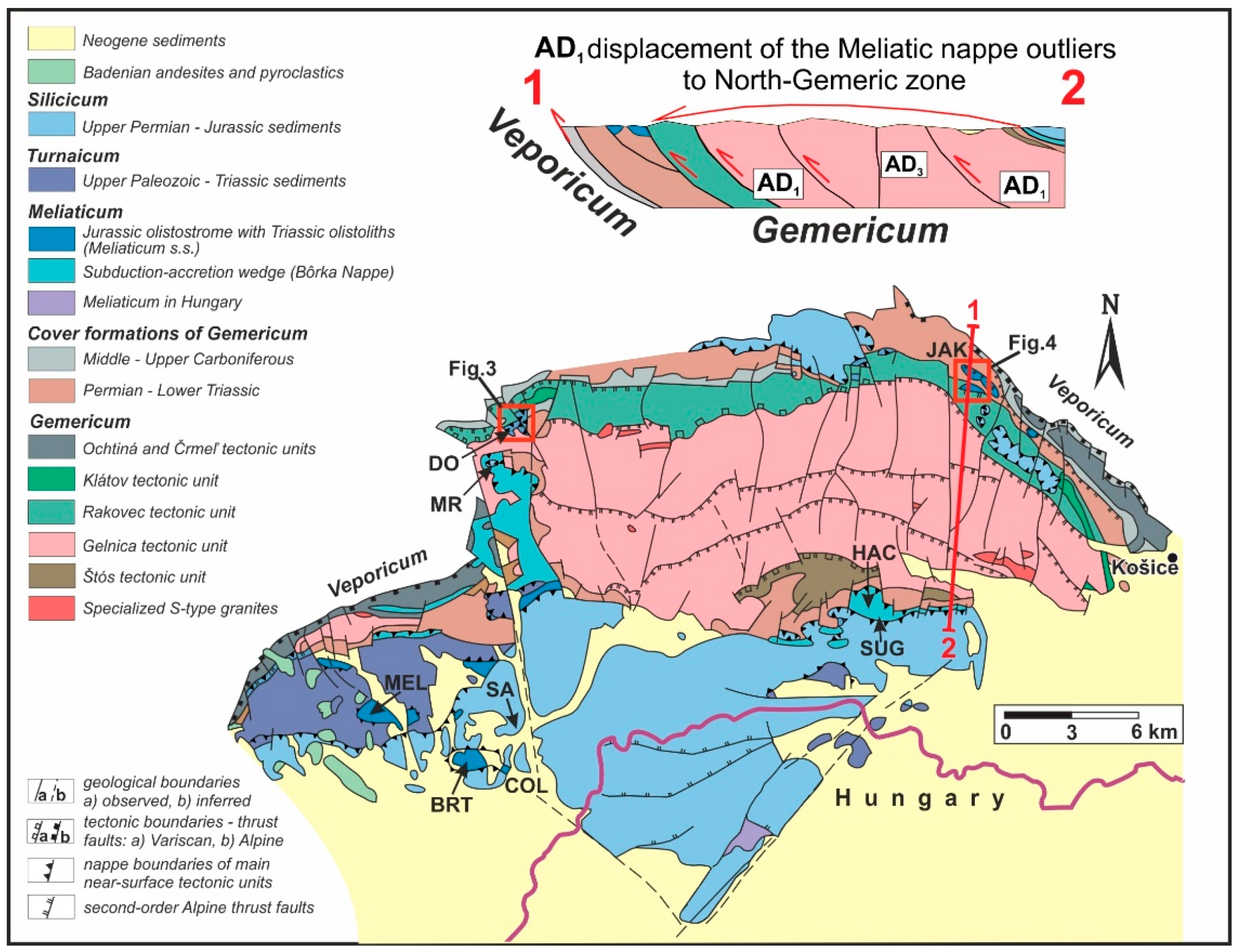
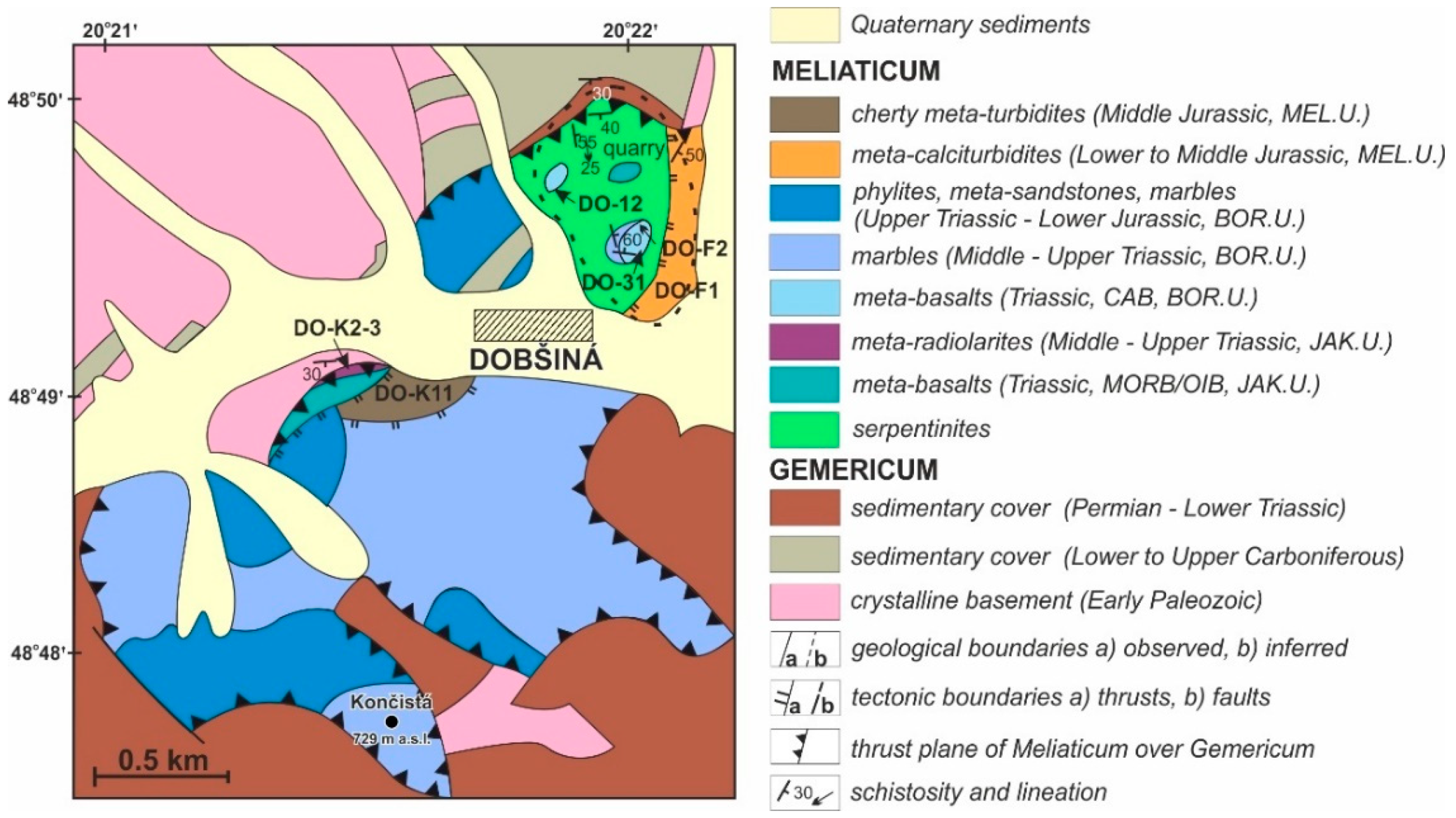
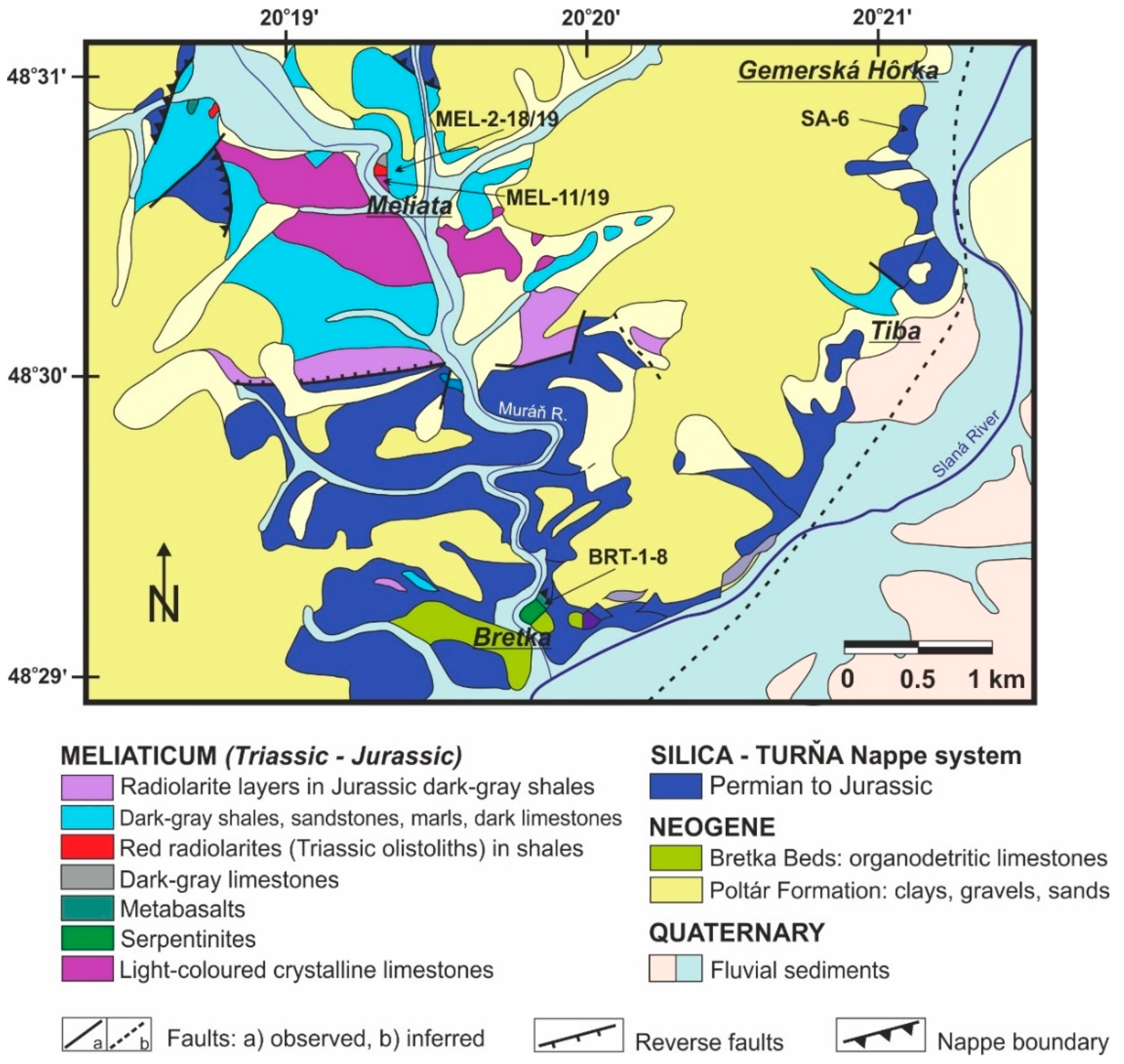

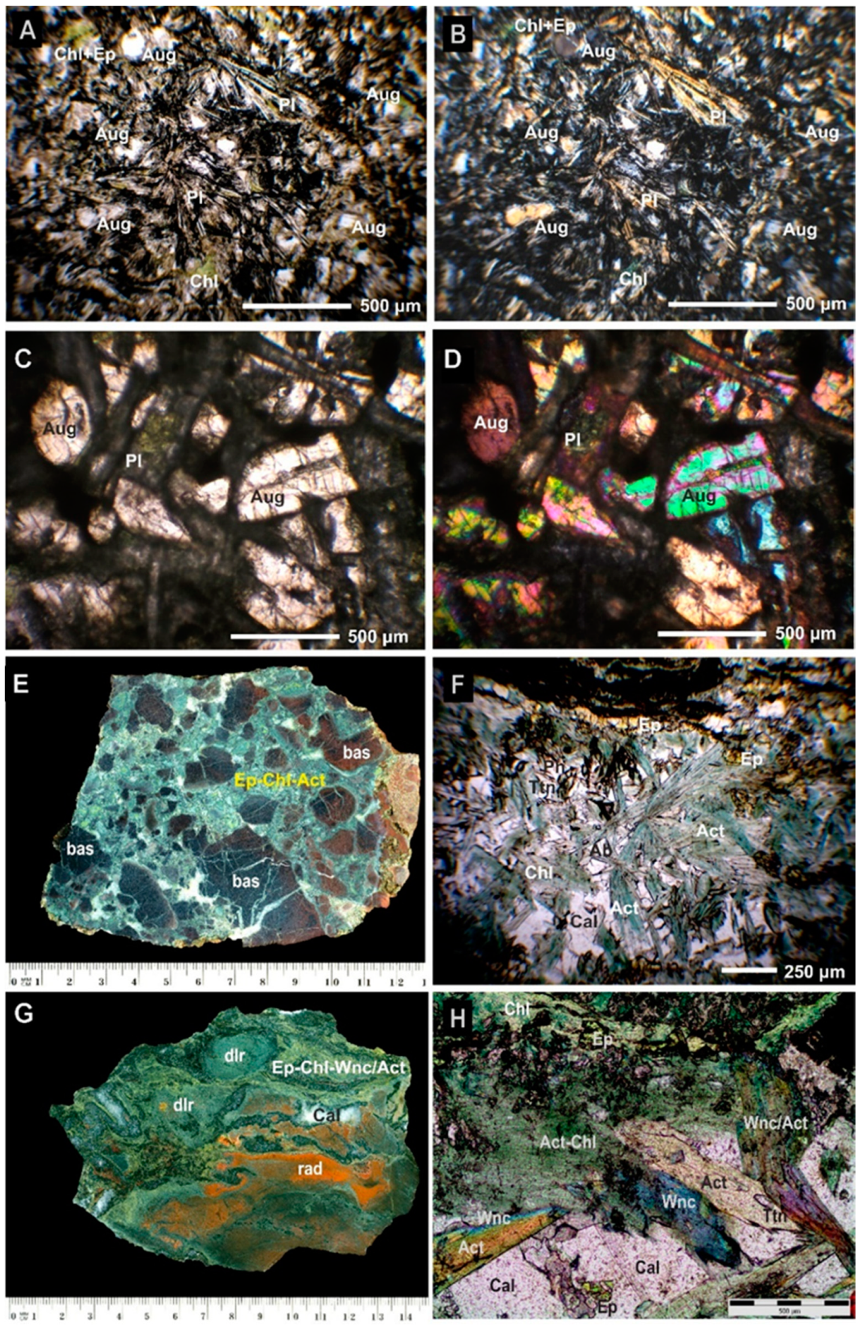
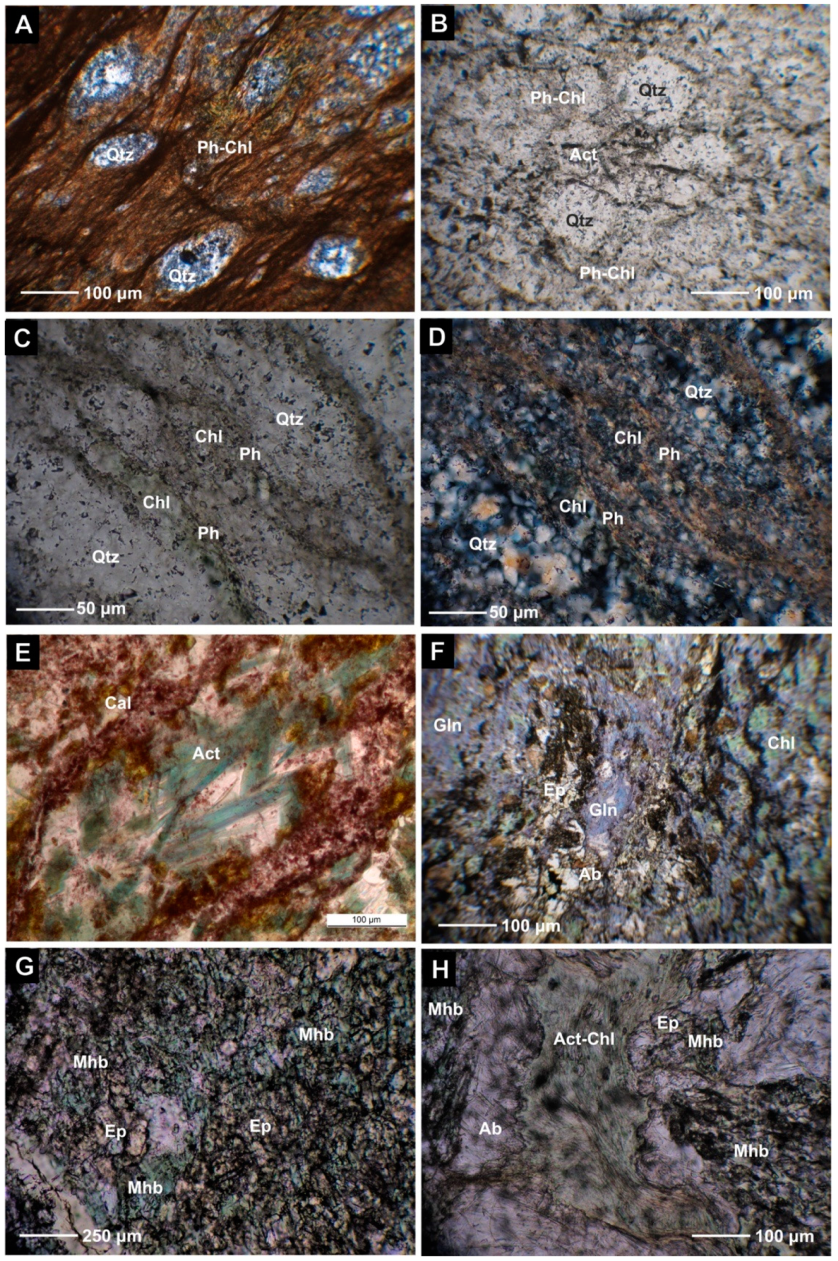
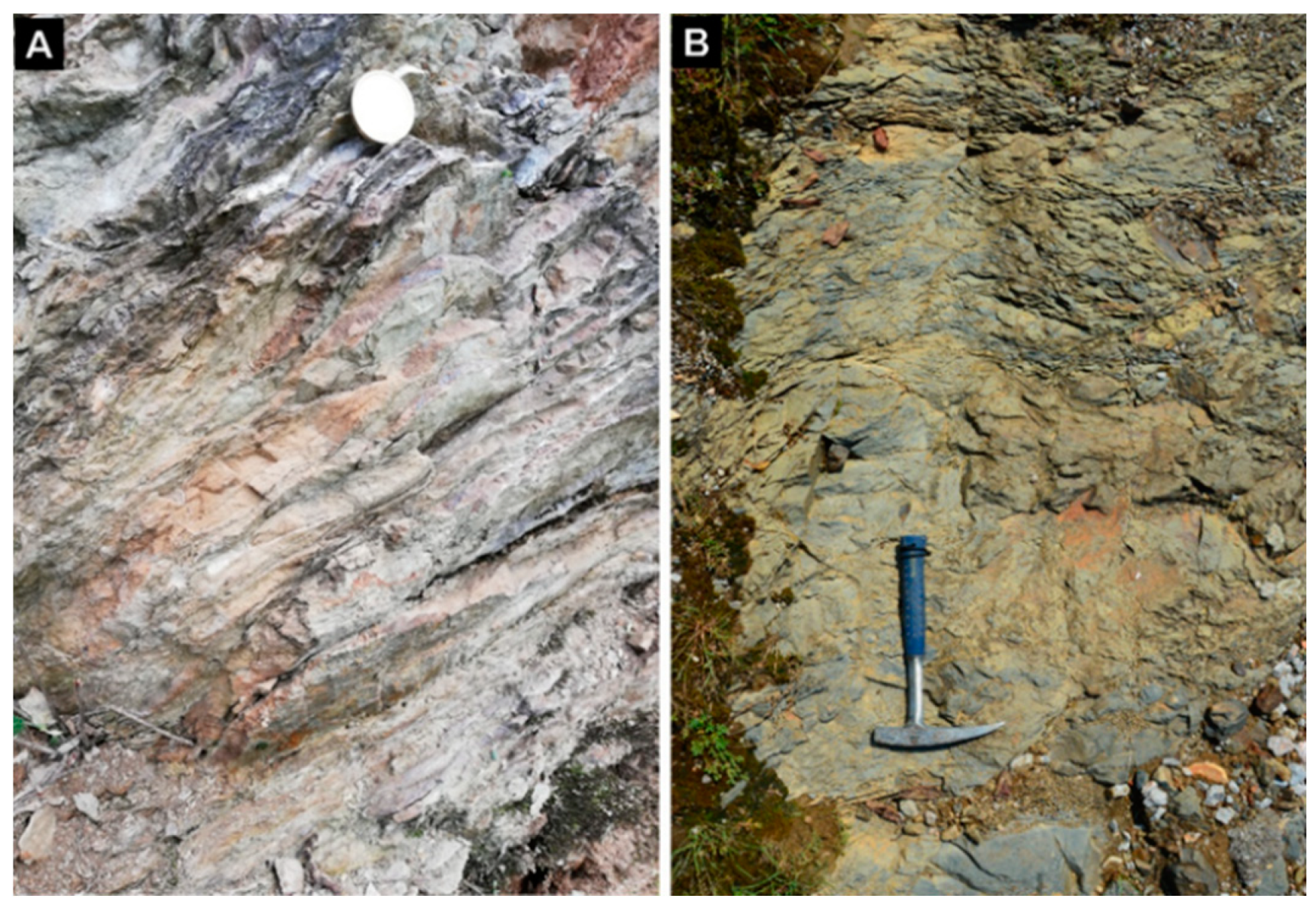

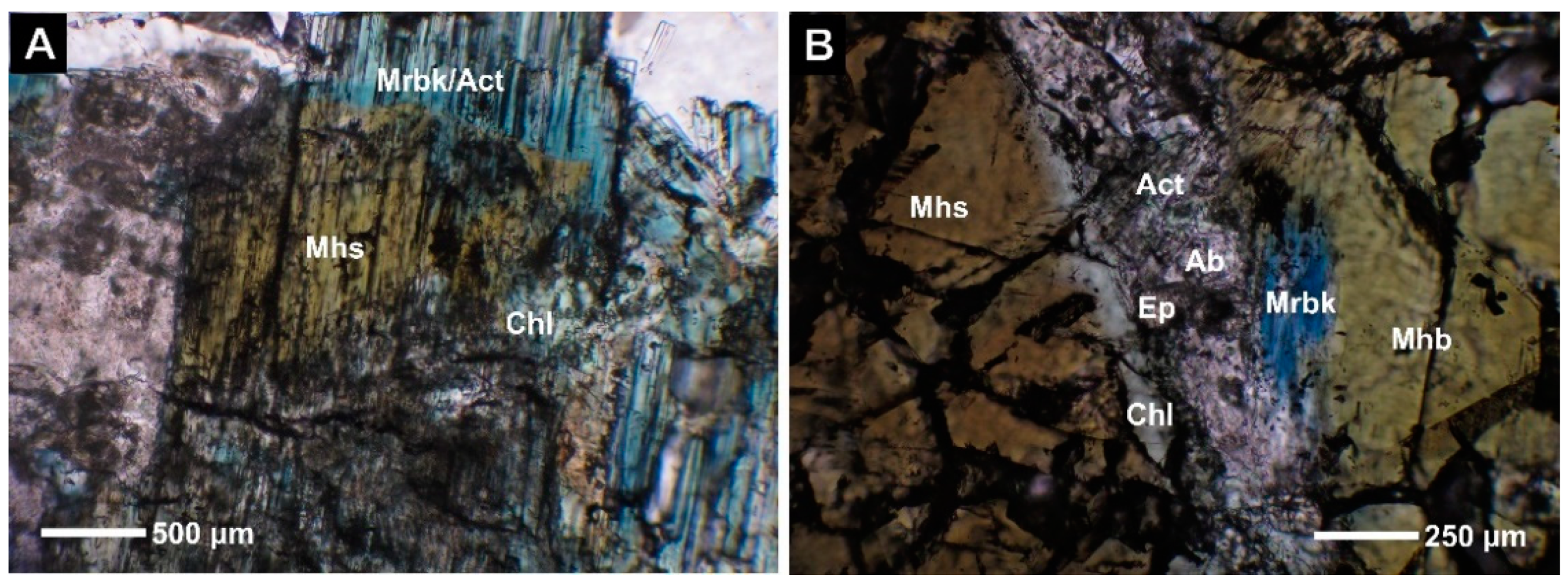
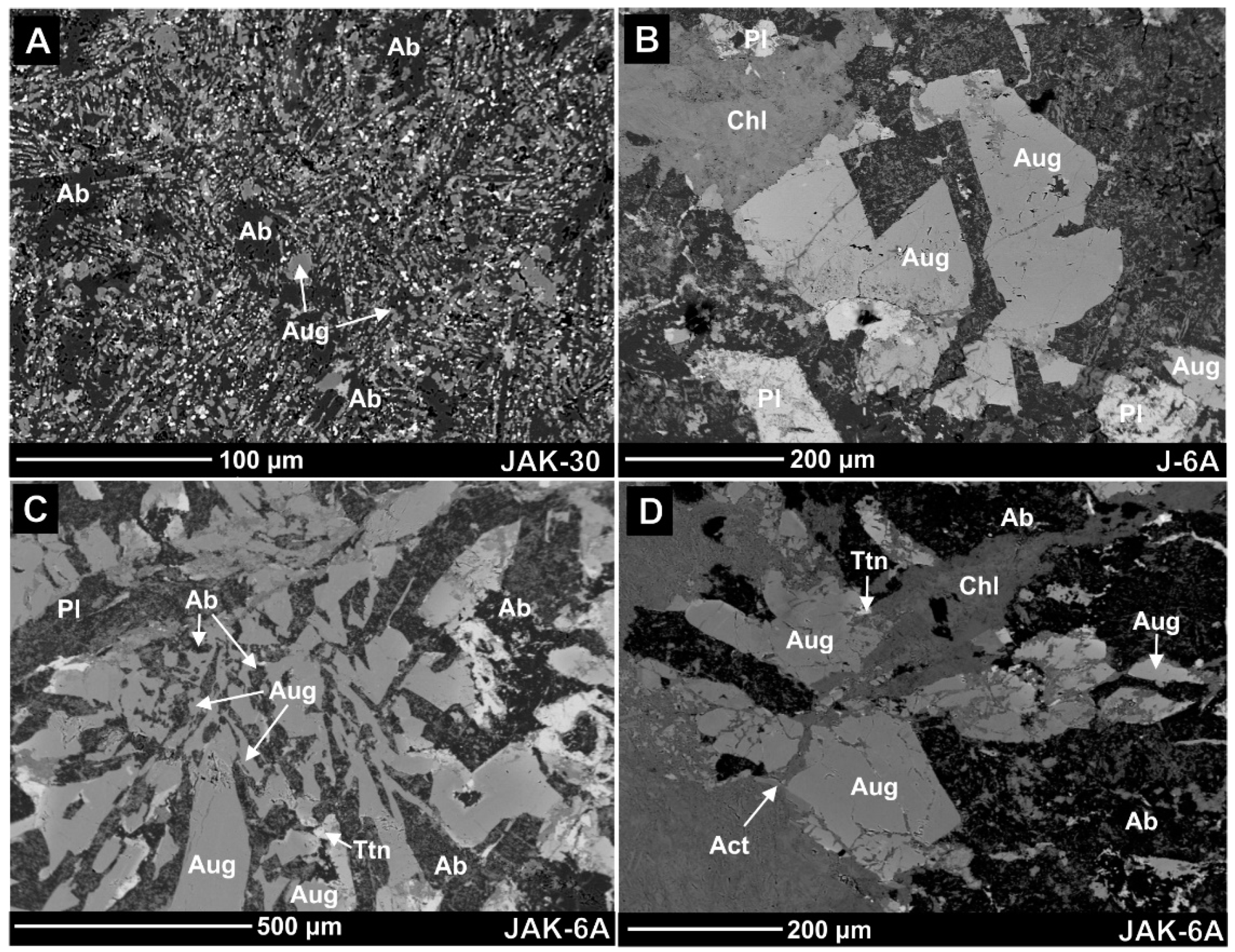

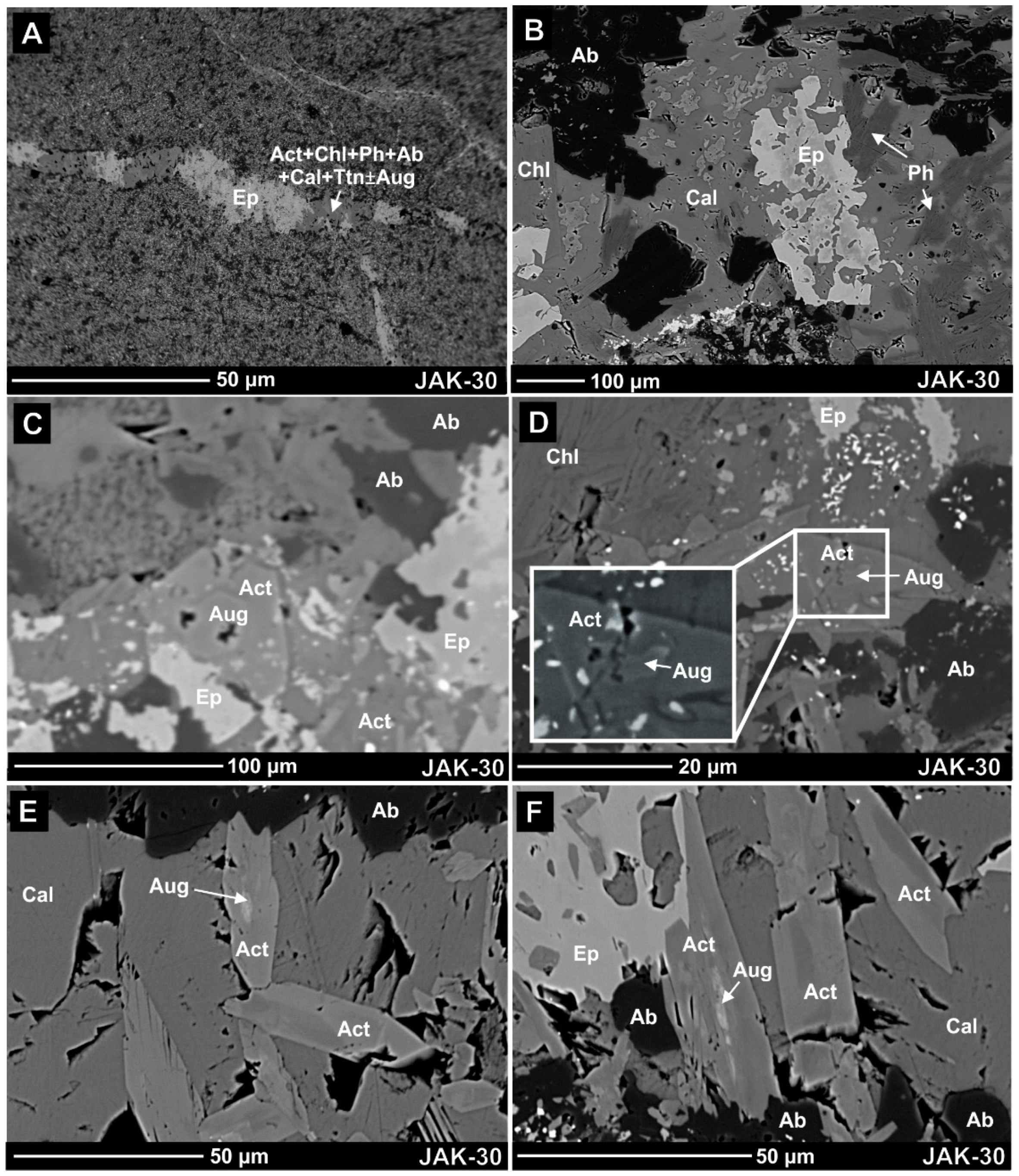

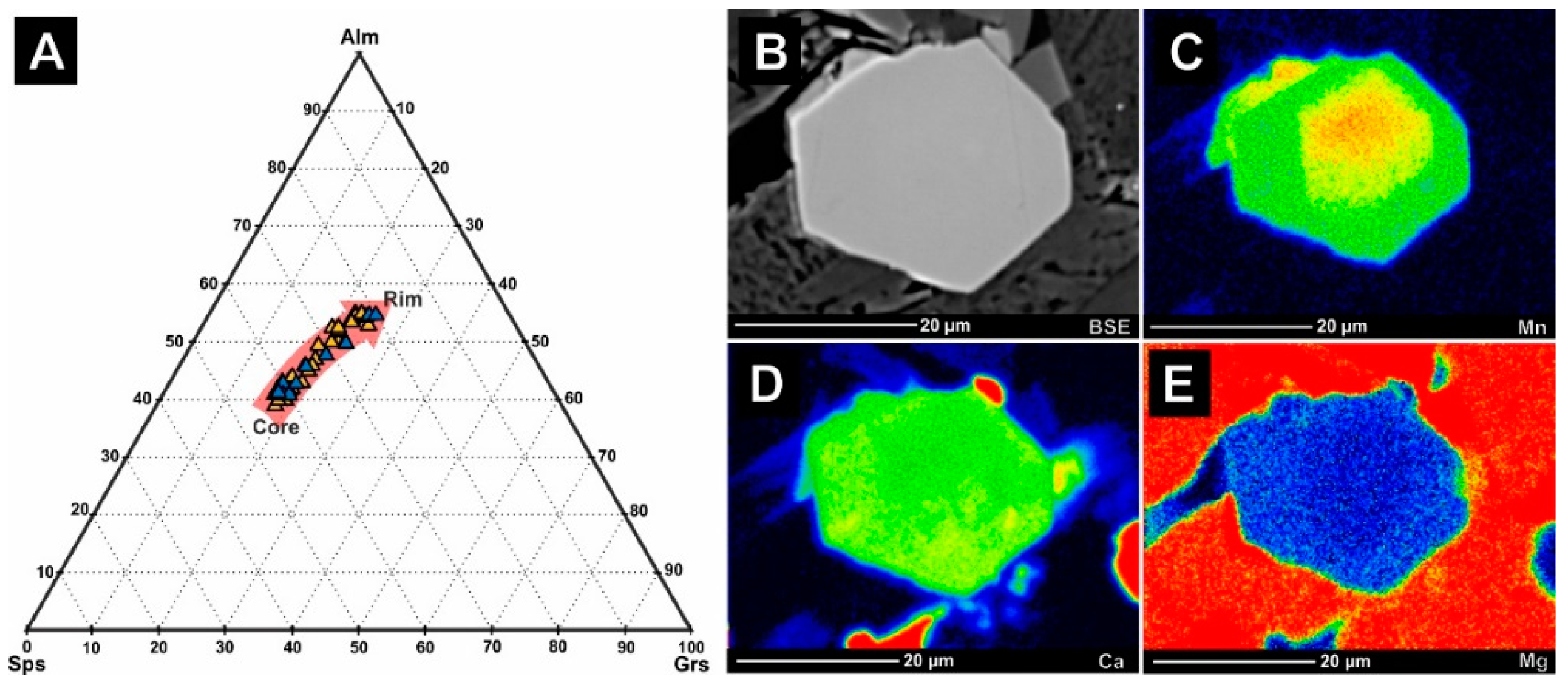
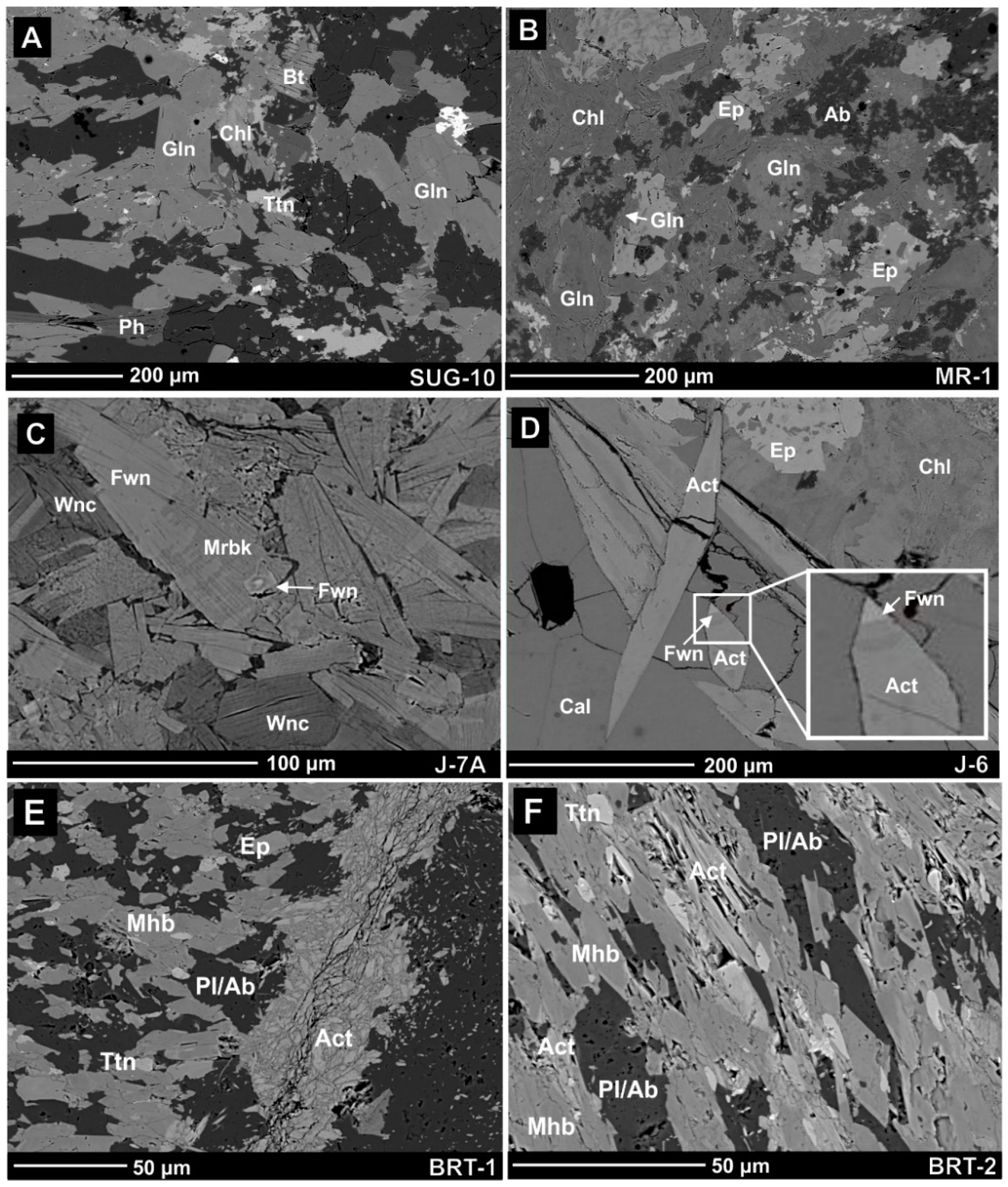
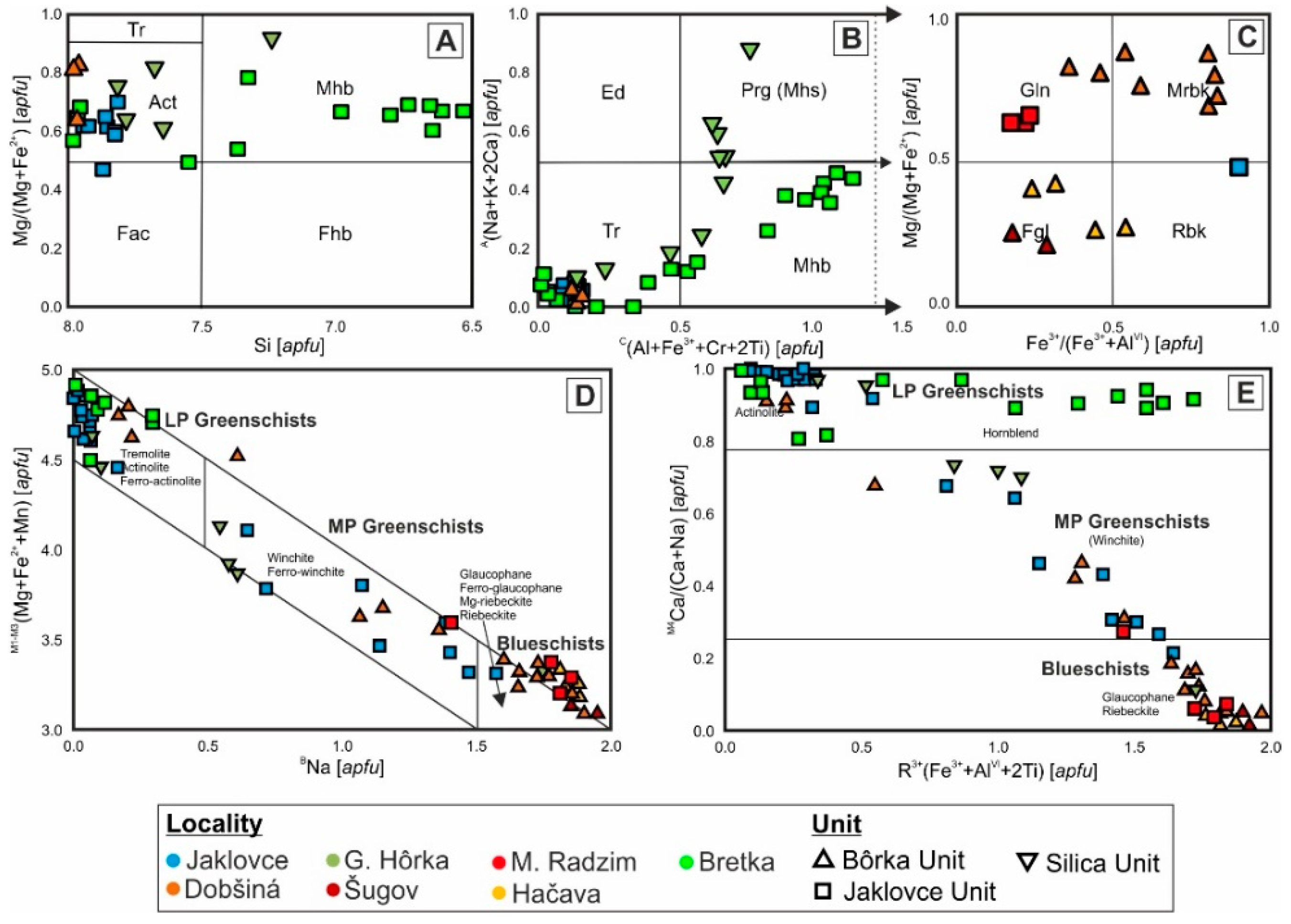

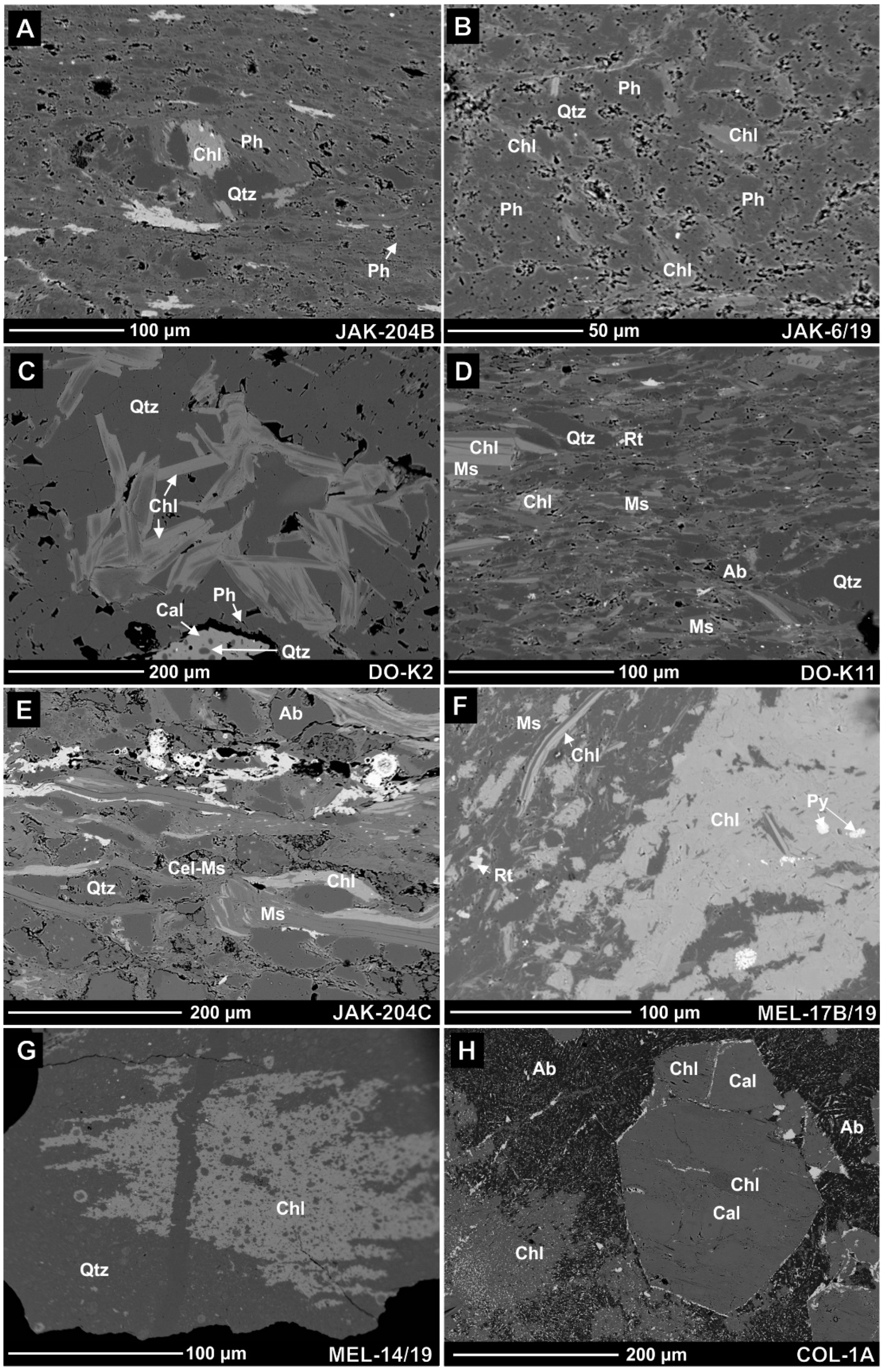
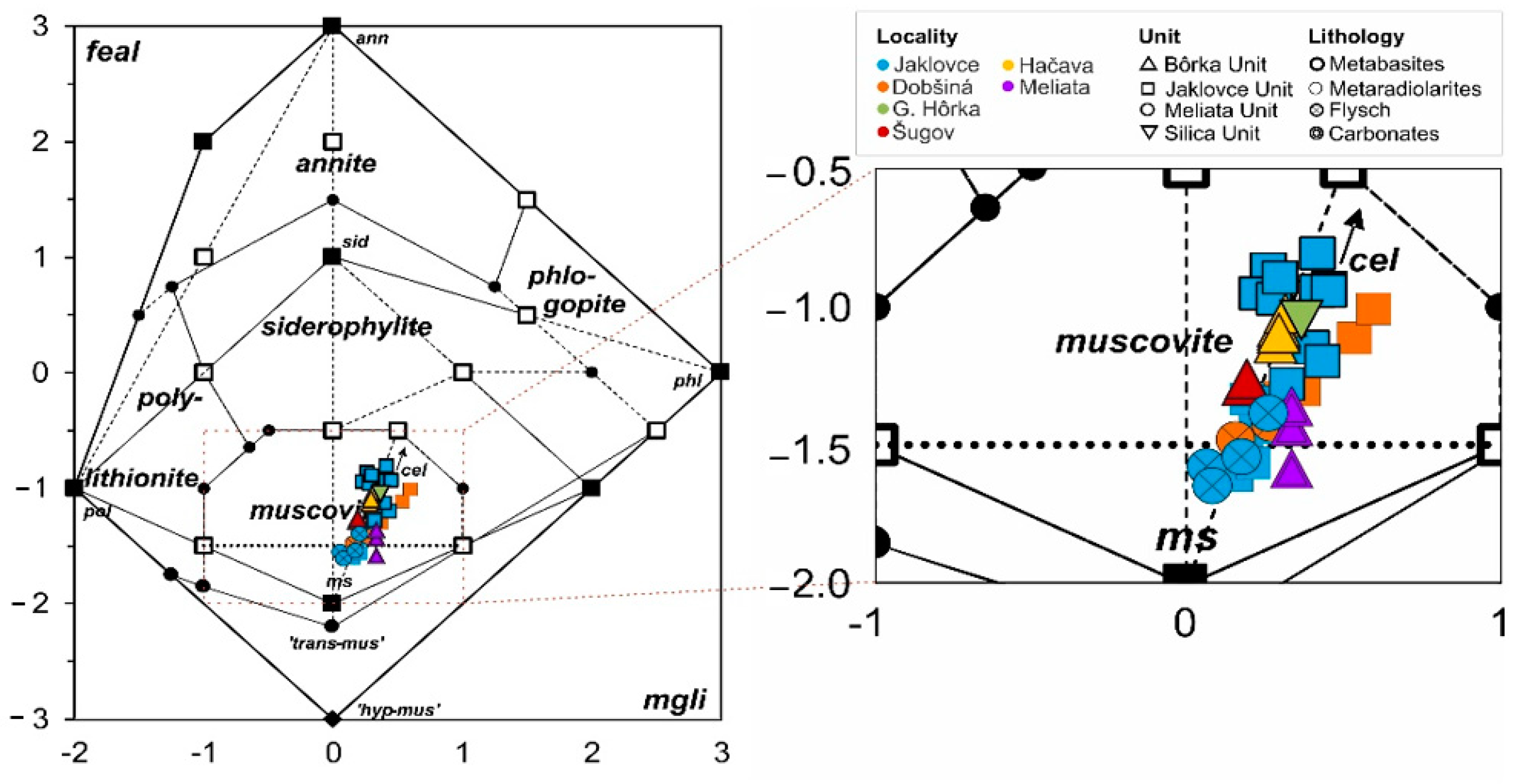

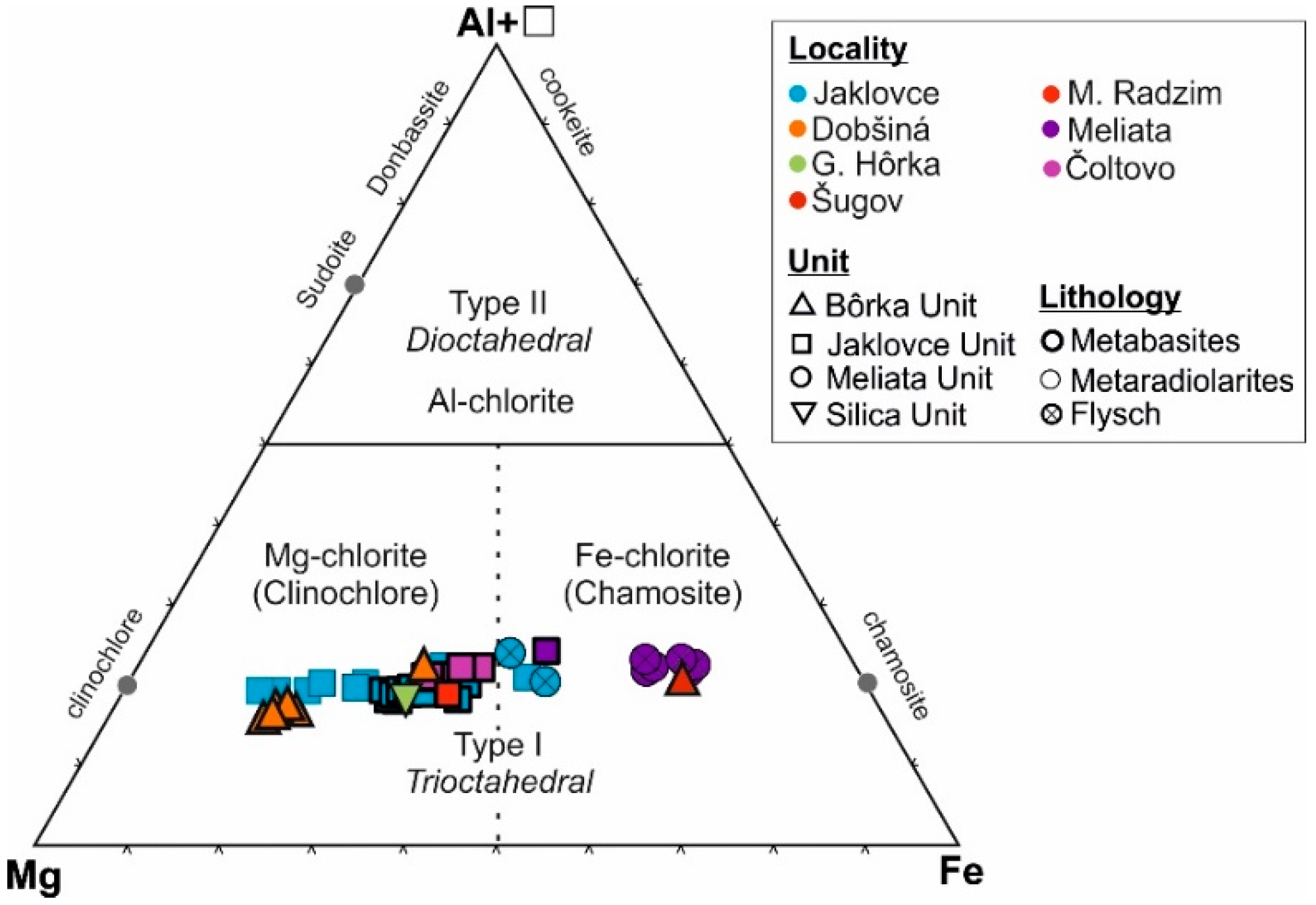
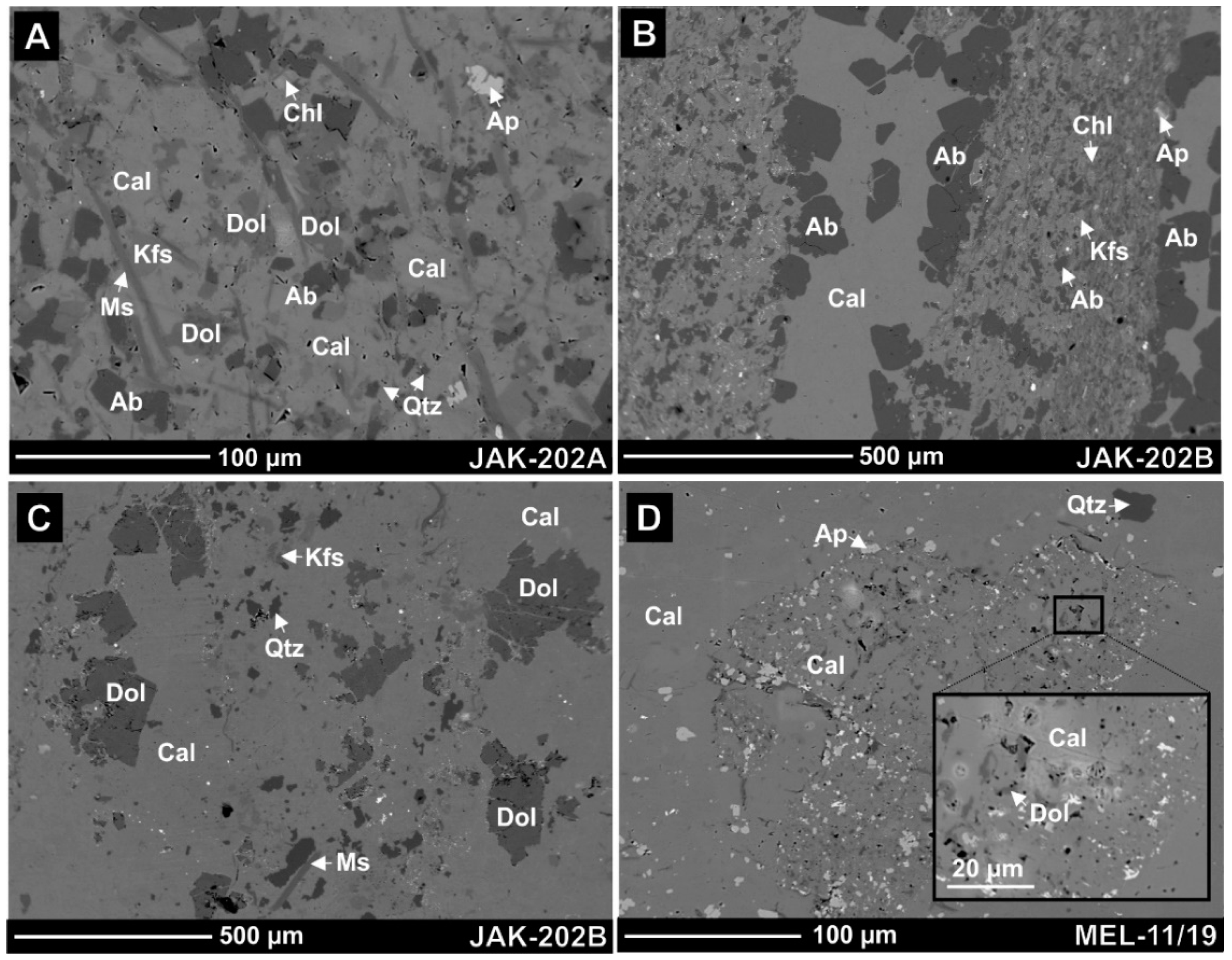
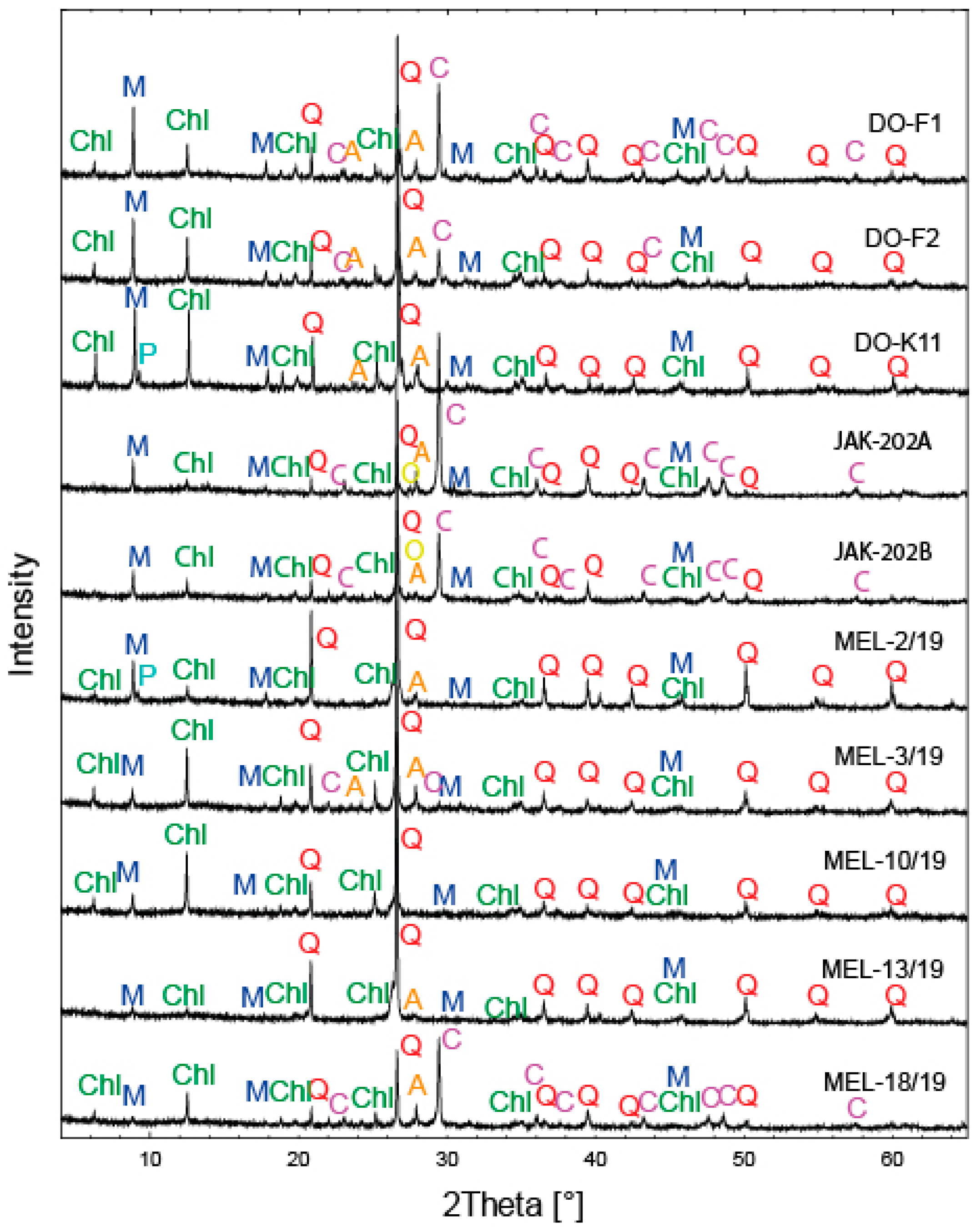
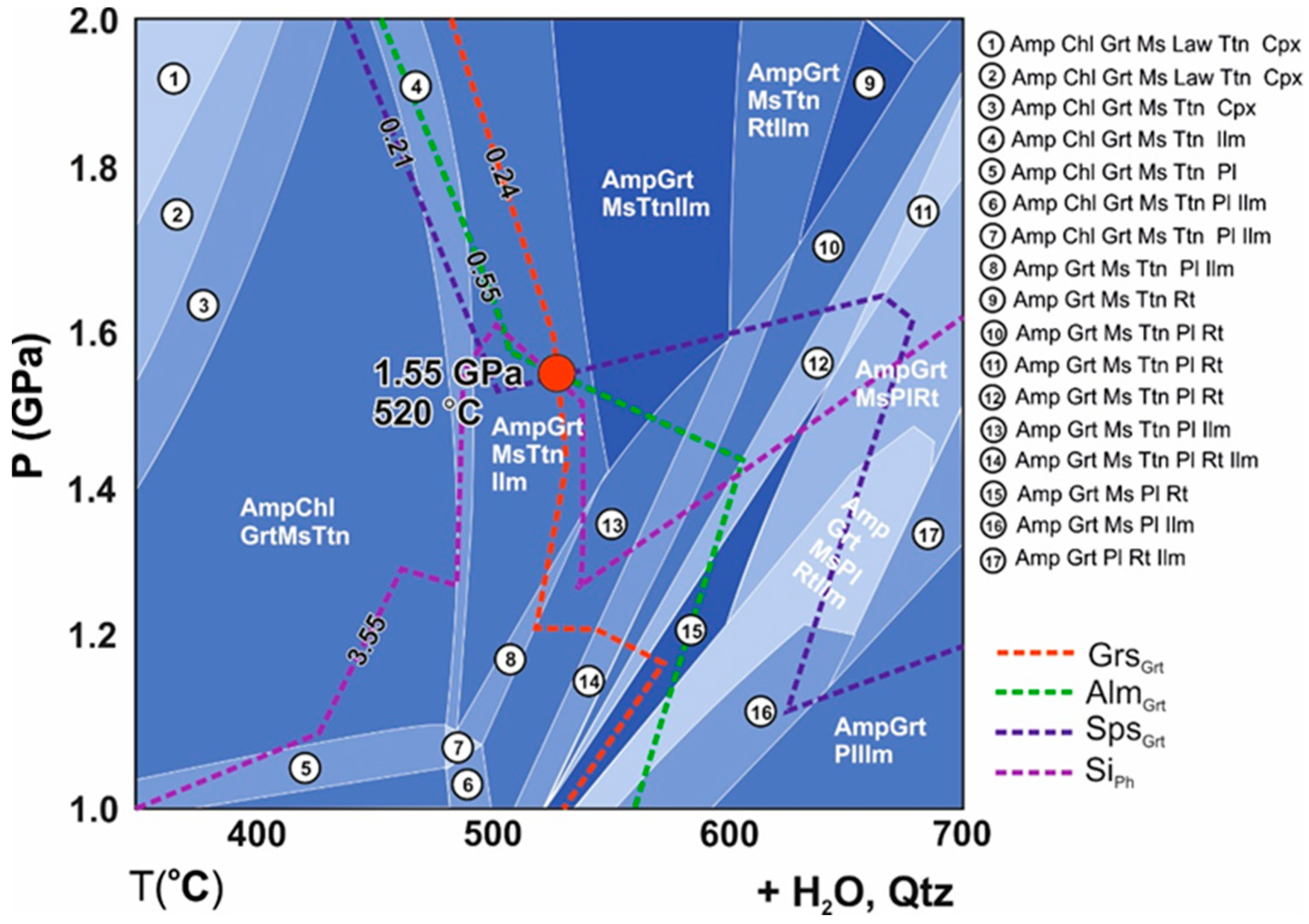
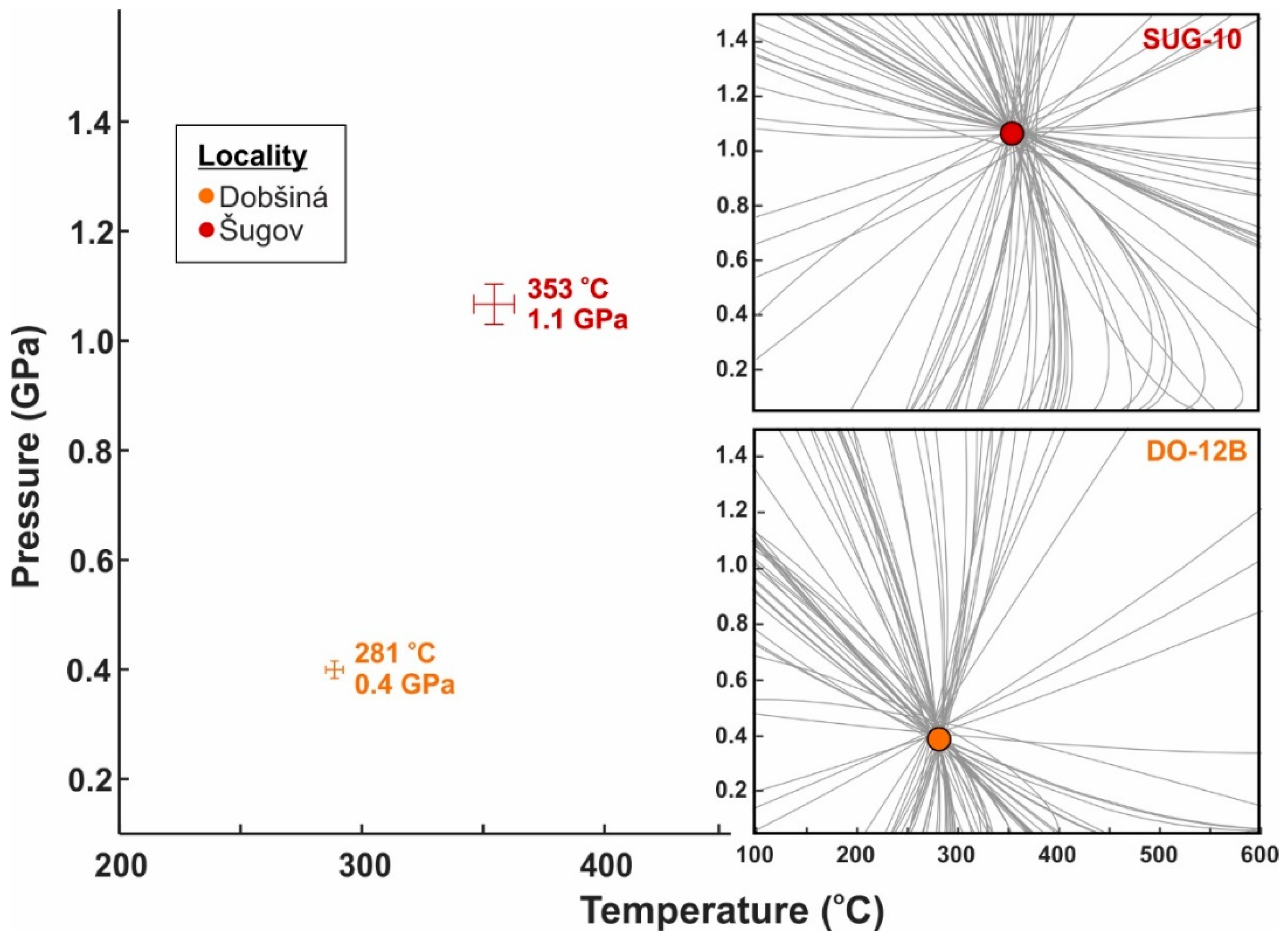

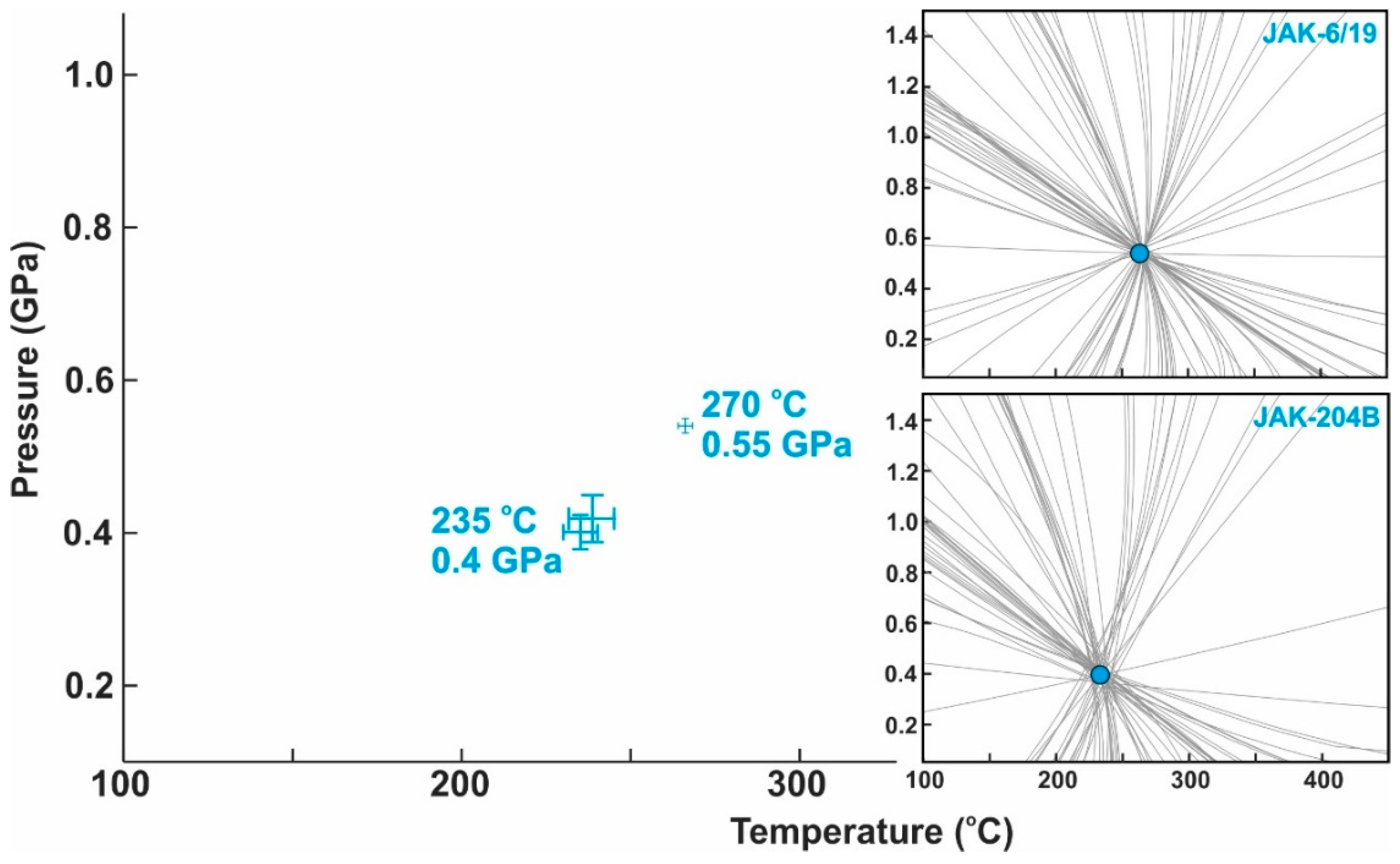

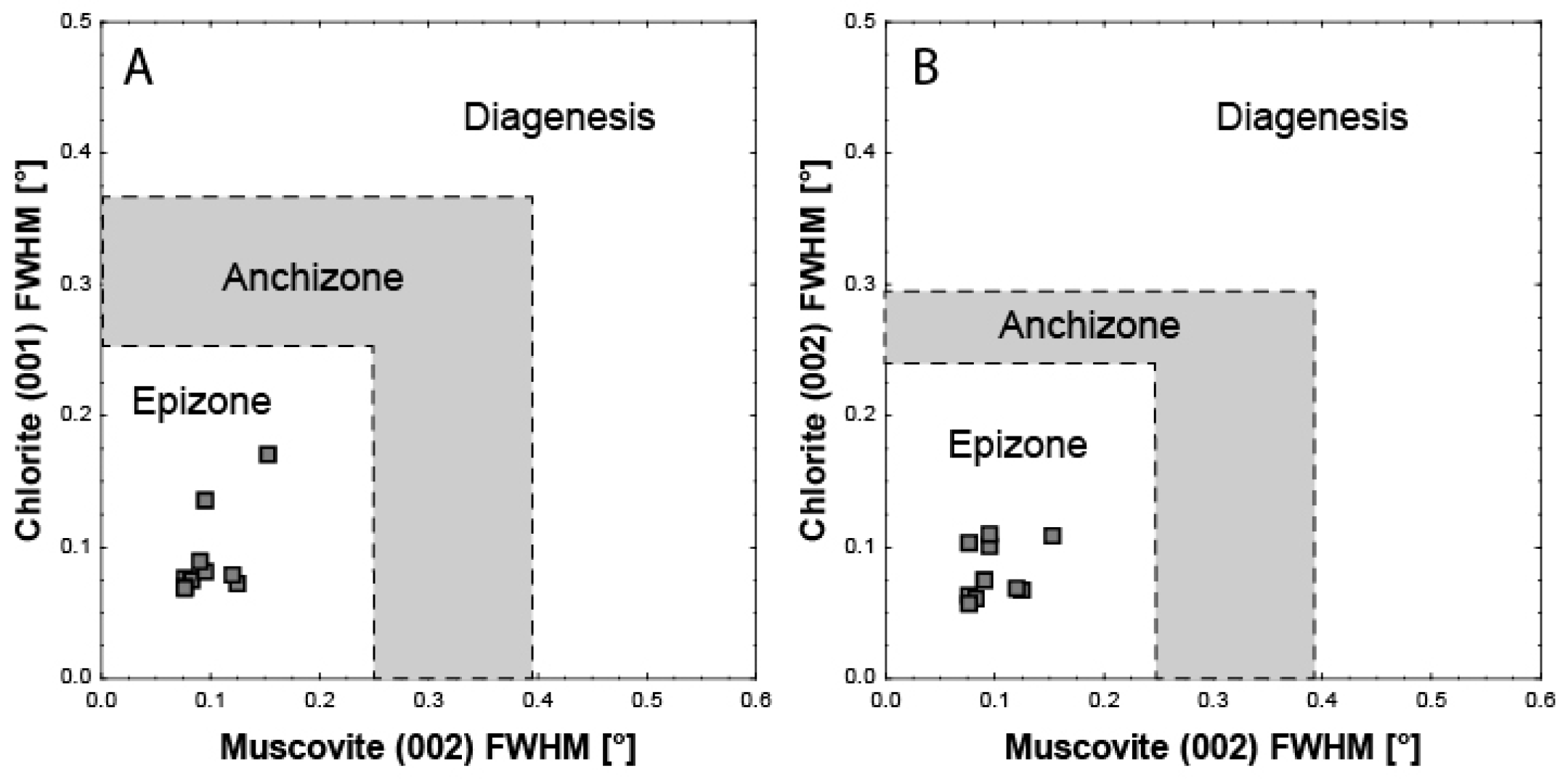
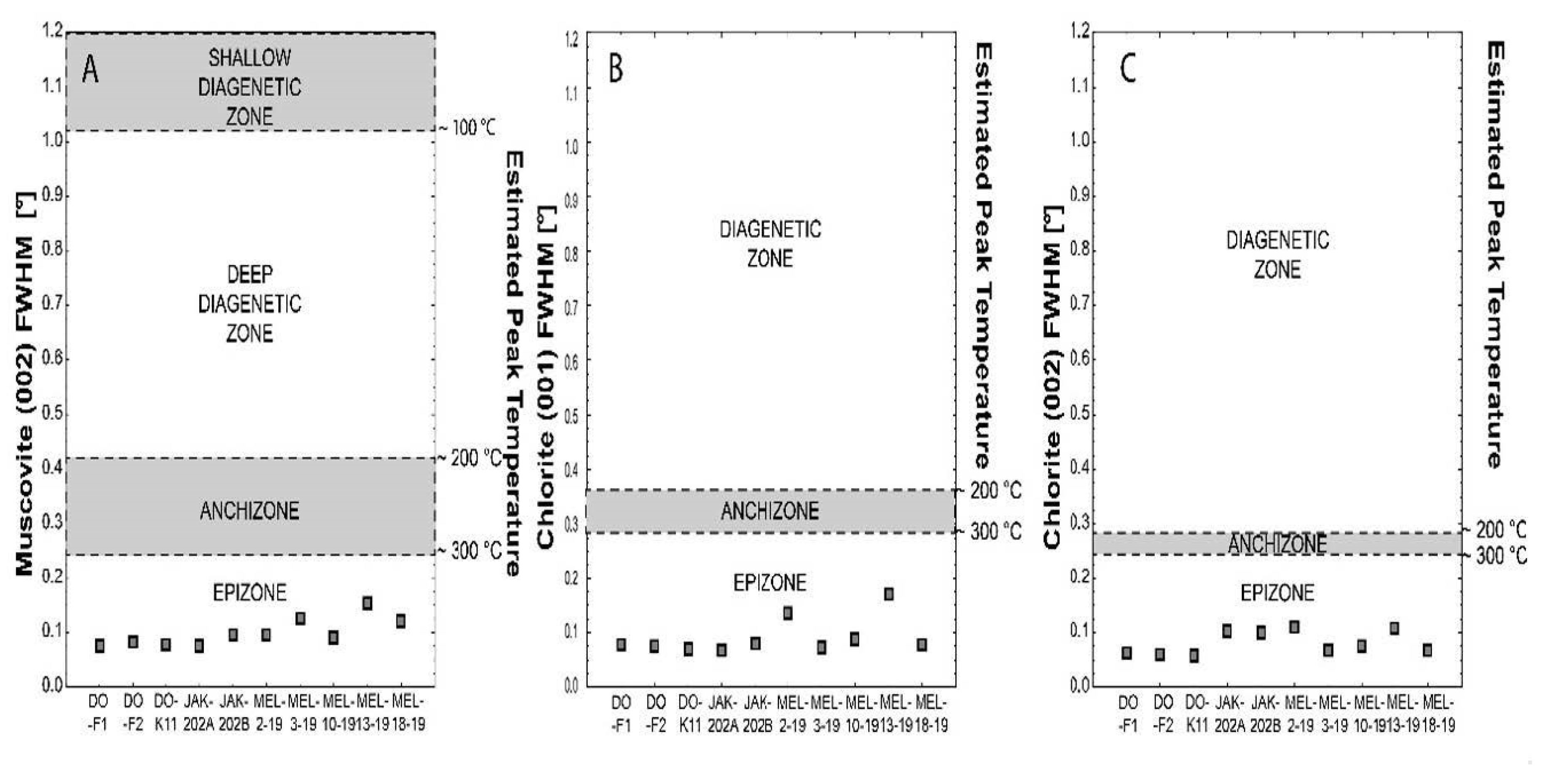
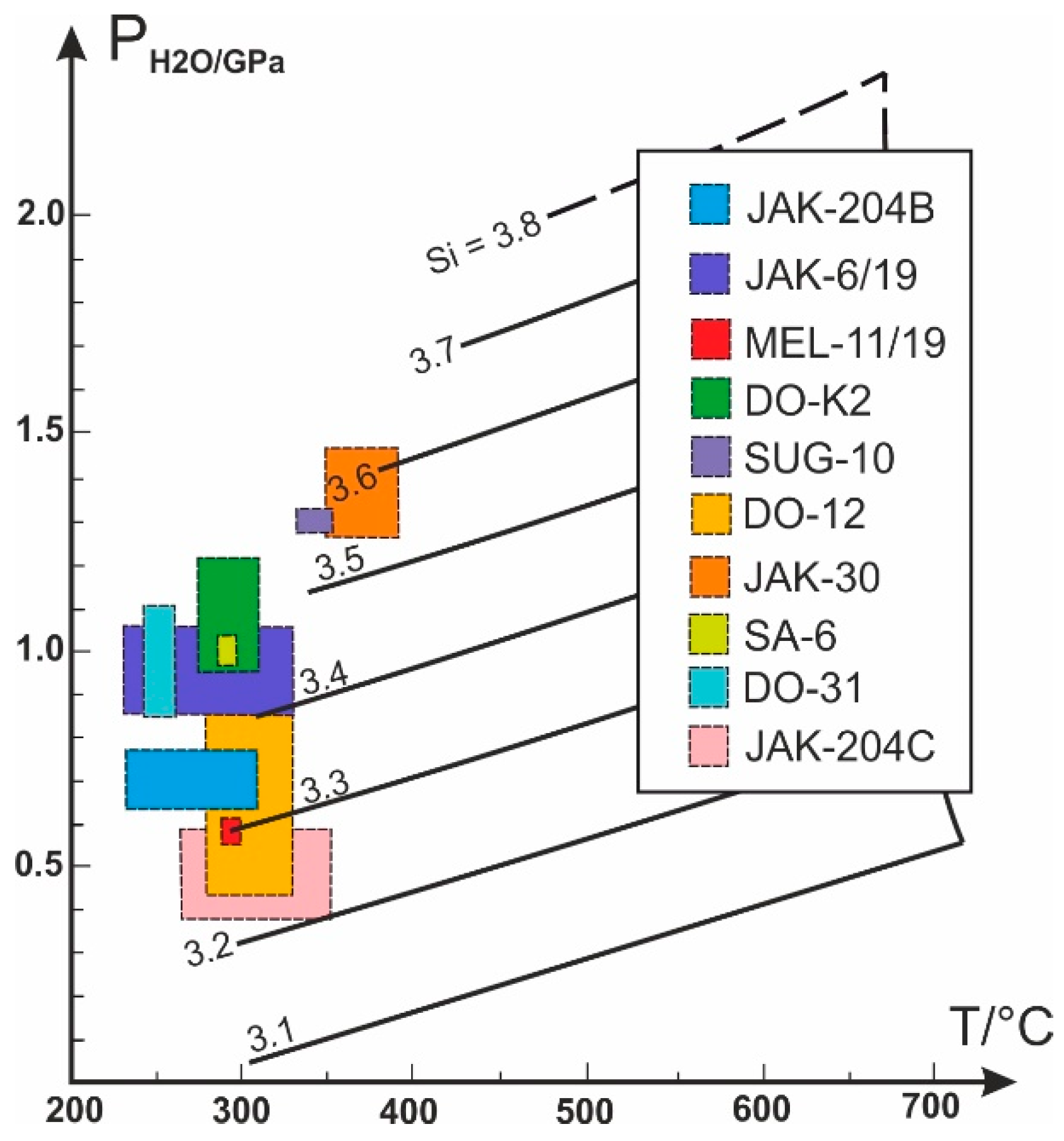
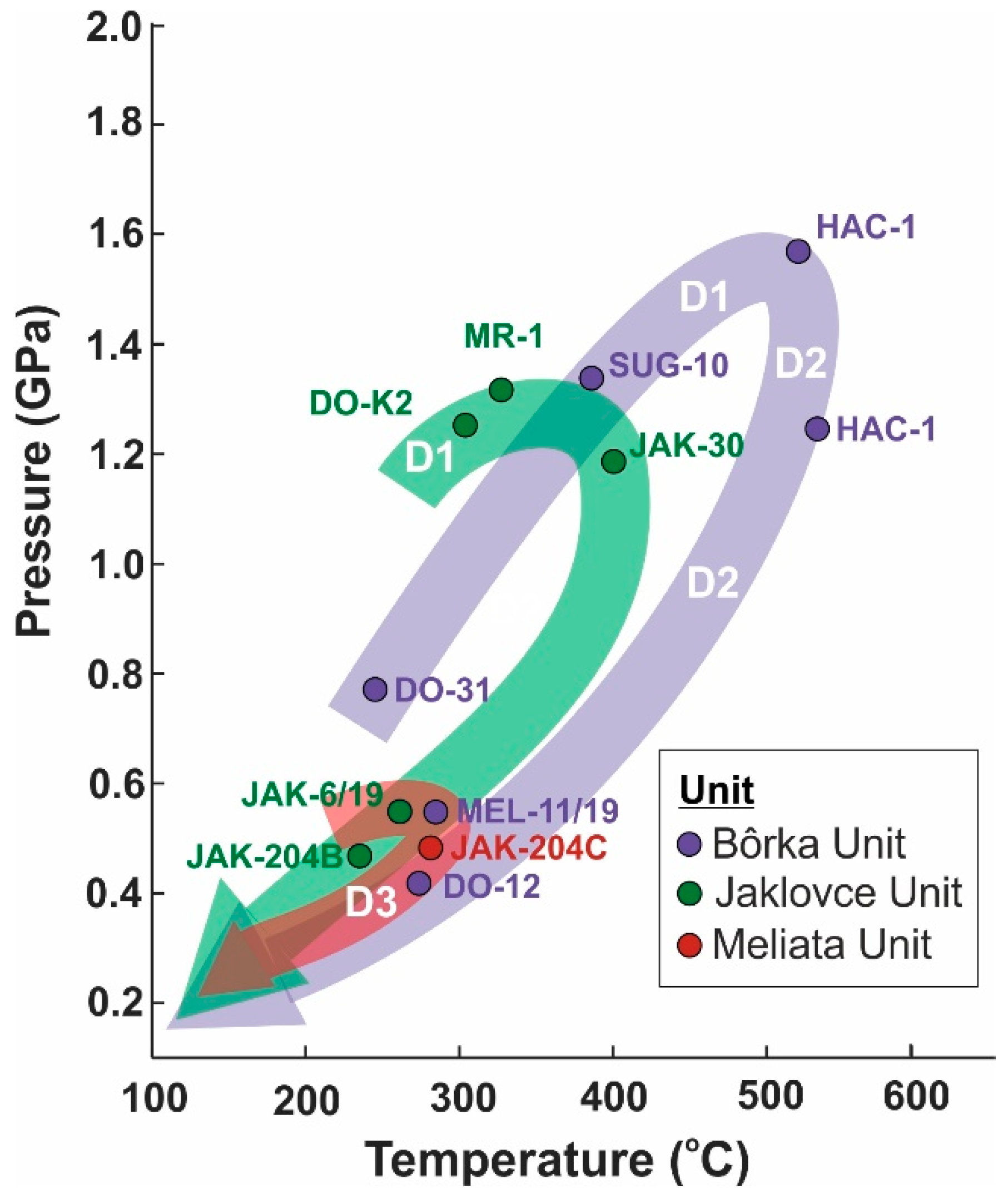
| Sample: | JAK-30 | JAK-30 | JAK-30 | JAK-30 | JAK-30 | JAK-30 | JAK-30 | JAK-6A | JAK6-A | J6-A |
|---|---|---|---|---|---|---|---|---|---|---|
| Mineral | Aug | Aug-(c) | Aug-(r) | Aug | Aug | Aug | Aug | Aug-(c) | Aug-(r) | Aug |
| An. N.: | 3 | 4 | 5 | 3 | 6 | 7 | 18 | 3 | 2 | 4 |
| Tectonic U.: | Jaklovce Unit | |||||||||
| SiO2 | 52.56 | 49.95 | 49.12 | 47.97 | 52.05 | 50.15 | 49.41 | 51.55 | 48.28 | 51.08 |
| TiO2 | 0.97 | 0.83 | 1.40 | 1.83 | 0.82 | 1.25 | 0.01 | 1.00 | 1.82 | 1.17 |
| Al2O3 | 7.37 | 4.53 | 5.49 | 7.09 | 2.79 | 5.20 | 5.06 | 3.05 | 3.84 | 2.13 |
| Cr2O3 | 0.21 | 0.00 | 0.06 | 0.06 | 0.12 | 0.13 | 0.02 | 0.21 | 0.03 | 0.00 |
| Fe2O3 * | 0.00 | 3.27 | 2.39 | 1.86 | 0.86 | 1.33 | 5.89 | 0.90 | 3.67 | 0.62 |
| FeO | 5.53 | 7.66 | 6.27 | 7.12 | 6.85 | 6.73 | 13.16 | 8.38 | 11.63 | 14.05 |
| MnO | 0.15 | 0.29 | 0.23 | 0.19 | 0.21 | 0.19 | 0.44 | 0.20 | 0.37 | 0.40 |
| MgO | 12.43 | 14.89 | 15.53 | 13.86 | 16.50 | 16.46 | 12.67 | 15.42 | 14.10 | 12.36 |
| CaO | 18.10 | 17.45 | 18.79 | 19.60 | 19.71 | 18.59 | 11.95 | 19.46 | 15.97 | 18.53 |
| Na2O | 2.44 | 0.76 | 0.37 | 0.40 | 0.26 | 0.22 | 1.02 | 0.34 | 0.39 | 0.41 |
| Total | 99.79 | 99.68 | 99.66 | 99.98 | 100.18 | 100.27 | 100.67 | 100.52 | 100.10 | 100.76 |
| Si4+ | 1.919 | 1.860 | 1.820 | 1.781 | 1.913 | 1.840 | 1.862 | 1.902 | 1.824 | 1.926 |
| Al3+ | 0.081 | 0.140 | 0.180 | 0.219 | 0.087 | 0.160 | 0.138 | 0.098 | 0.171 | 0.074 |
| Σ | 2.00 | 2.00 | 2.00 | 2.00 | 2.00 | 2.00 | 2.00 | 2.00 | 2.00 | 2.00 |
| Ti4+ | 0.027 | 0.023 | 0.039 | 0.051 | 0.023 | 0.035 | 0.000 | 0.028 | 0.052 | 0.033 |
| Al3+ | 0.236 | 0.058 | 0.060 | 0.092 | 0.034 | 0.065 | 0.087 | 0.035 | 0.000 | 0.020 |
| Fe3+ | 0.000 | 0.092 | 0.067 | 0.052 | 0.024 | 0.037 | 0.167 | 0.025 | 0.104 | 0.017 |
| Cr3+ | 0.006 | 0.000 | 0.002 | 0.002 | 0.003 | 0.004 | 0.000 | 0.006 | 0.001 | 0.000 |
| Fe2+ | 0.056 | 0.000 | 0.000 | 0.036 | 0.013 | 0.000 | 0.033 | 0.058 | 0.049 | 0.234 |
| Mg2+ | 0.676 | 0.827 | 0.832 | 0.767 | 0.904 | 0.860 | 0.712 | 0.848 | 0.794 | 0.695 |
| Mn2+ | 0.000 | 0.000 | 0.000 | 0.000 | 0.000 | 0.000 | 0.000 | 0.000 | 0.000 | 0.000 |
| Σ | 1.00 | 1.00 | 1.00 | 1.00 | 1.00 | 1.00 | 1.00 | 1.00 | 1.00 | 1.00 |
| Fe2+ | 0.113 | 0.238 | 0.194 | 0.185 | 0.198 | 0.206 | 0.382 | 0.200 | 0.319 | 0.209 |
| Mn2+ | 0.005 | 0.009 | 0.007 | 0.006 | 0.006 | 0.006 | 0.014 | 0.006 | 0.012 | 0.013 |
| Mg2+ | 0.000 | 0.000 | 0.025 | 0.000 | 0.000 | 0.041 | 0.000 | 0.000 | 0.000 | 0.000 |
| Ca2+ | 0.708 | 0.696 | 0.746 | 0.780 | 0.776 | 0.731 | 0.482 | 0.769 | 0.646 | 0.749 |
| Na+ | 0.173 | 0.055 | 0.027 | 0.029 | 0.019 | 0.016 | 0.075 | 0.024 | 0.028 | 0.030 |
| Σ | 1.00 | 1.00 | 1.00 | 1.00 | 1.00 | 1.00 | 1.00 | 1.00 | 1.00 | 1.00 |
| Total | 4.00 | 4.00 | 4.00 | 4.00 | 4.00 | 4.00 | 4.00 | 4.00 | 4.00 | 4.00 |
| Wo | 0.65 | 0.58 | 0.61 | 0.61 | 0.71 | 0.61 | 0.35 | 0.70 | 0.53 | 0.71 |
| En | 0.68 | 0.83 | 0.86 | 0.77 | 0.90 | 0.90 | 0.71 | 0.85 | 0.79 | 0.69 |
| Fs | 0.17 | 0.24 | 0.19 | 0.22 | 0.21 | 0.21 | 0.41 | 0.26 | 0.37 | 0.44 |
| Sample: | HAC-2 | HAC-2 | HAC-2 | HAC-2 | HAC-2 | HAC-2 | HAC-2 |
|---|---|---|---|---|---|---|---|
| Mineral | Grt-(r) | Grt-(t) | Grt-(c) | Grt-(c) | Grt-(c) | Grt-(t) | Grt-(r) |
| An. N.: | 1 | 2 | 3 | 5 | 7 | 10 | 3 |
| Tectonic U.: | Bôrka Unit | ||||||
| SiO2 | 37.61 | 36.89 | 36.82 | 37.23 | 37.38 | 37.09 | 37.30 |
| TiO2 | 0.09 | 0.18 | 0.19 | 0.17 | 0.19 | 0.13 | 0.09 |
| Al2O3 | 20.21 | 19.85 | 19.65 | 19.65 | 19.96 | 19.90 | 20.30 |
| Cr2O3 | 0.00 | 0.02 | 0.03 | 0.01 | 0.04 | 0.01 | 0.00 |
| FeO | 24.28 | 21.47 | 19.26 | 18.54 | 19.16 | 20.51 | 23.97 |
| MnO | 8.82 | 12.69 | 16.35 | 16.55 | 15.87 | 14.52 | 8.62 |
| MgO | 0.32 | 0.23 | 0.21 | 0.16 | 0.18 | 0.19 | 0.38 |
| CaO | 9.15 | 8.55 | 7.45 | 8.12 | 7.98 | 8.14 | 9.15 |
| Na2O | 0.12 | 0.00 | 0.02 | 0.04 | 0.03 | 0.00 | 0.02 |
| Total | 100.59 | 99.87 | 99.99 | 100.47 | 100.79 | 100.51 | 99.83 |
| Si4+ | 3.015 | 2.992 | 2.993 | 3.007 | 3.008 | 2.993 | 3.012 |
| Ti4+ | 0.005 | 0.011 | 0.012 | 0.010 | 0.011 | 0.008 | 0.005 |
| Al3+ | 1.910 | 1.897 | 1.882 | 1.870 | 1.893 | 1.893 | 1.933 |
| Cr3+ | 0.000 | 0.001 | 0.002 | 0.001 | 0.003 | 0.001 | 0.000 |
| Fe3+ | 0.067 | 0.096 | 0.110 | 0.101 | 0.070 | 0.104 | 0.035 |
| Fe2+ | 1.561 | 1.360 | 1.198 | 1.152 | 1.220 | 1.280 | 1.584 |
| Mg2+ | 0.039 | 0.028 | 0.025 | 0.018 | 0.022 | 0.023 | 0.046 |
| Mn2+ | 0.599 | 0.872 | 1.125 | 1.132 | 1.082 | 0.993 | 0.590 |
| Ca2+ | 0.786 | 0.743 | 0.649 | 0.703 | 0.688 | 0.704 | 0.792 |
| Na+ | 0.018 | 0.000 | 0.003 | 0.006 | 0.004 | 0.000 | 0.003 |
| Total | 8.00 | 8.00 | 8.00 | 8.00 | 8.00 | 8.00 | 8.00 |
| Alm | 0.55 | 0.48 | 0.43 | 0.41 | 0.43 | 0.46 | 0.55 |
| Sps | 0.21 | 0.31 | 0.40 | 0.40 | 0.38 | 0.35 | 0.20 |
| Grs | 0.24 | 0.21 | 0.17 | 0.19 | 0.19 | 0.19 | 0.25 |
| Sample: | HAC-1 | HAC-1 | HAC-1 | SUG-10 | DO-31 | DO-31 | DO-31 | DO-31 | JAK-30 | J-7A | J-6 | J-6 | MR-1 | BRT-1 | BRT-1 | SA-6 | SA-6 | SA-6 | SA-6 |
|---|---|---|---|---|---|---|---|---|---|---|---|---|---|---|---|---|---|---|---|
| Mineral | Gln(c) | Gln(r) | Rbk | Gln | Gln | Mrbk | Fwn | Act | Act | Rbk | Fwn | Act | Gln | Mhb | Act | Mrbk | Act | Mhs | Mhb |
| An. N.: | 10 | 11 | 9 | 1 | 1 | 2 | 3 | 4 | 1 | 5 | 3 | 1 | 1 | 10 | 11 | 2 | 5 | 8 | 10 |
| Tectonic U.: | Bôrka Unit | Jaklovce U. | Jaklovce Unit | Silica Unit | |||||||||||||||
| SiO2 | 54.90 | 56.54 | 54.56 | 54.02 | 59.02 | 57.39 | 56.14 | 55.25 | 53.39 | 54.39 | 54.55 | 53.66 | 57.58 | 49.20 | 54.64 | 56.04 | 54.58 | 43.51 | 51.15 |
| TiO2 | 0.00 | 0.02 | 0.00 | 0.02 | 0.09 | 0.04 | 0.00 | 0.05 | 0.00 | 0.00 | 0.05 | 0.00 | 0.02 | 0.09 | 0.00 | 0.02 | 0.14 | 2.05 | 0.33 |
| Al2O3 | 5.88 | 7.83 | 4.79 | 8.08 | 5.57 | 2.18 | 2.33 | 0.47 | 1.43 | 0.83 | 1.58 | 0.57 | 8.58 | 4.93 | 0.14 | 3.15 | 1.24 | 9.09 | 4.94 |
| Cr2O3 | 0.00 | 0.00 | 0.00 | 0.00 | 0.00 | 0.00 | 0.00 | 0.00 | 0.00 | 0.00 | 0.02 | 0.02 | 0.01 | 0.00 | 0.00 | 0.00 | 0.02 | 0.00 | 0.03 |
| FeO | 26.12 | 20.14 | 26.80 | 24.49 | 12.76 | 15.22 | 12.36 | 14.35 | 12.04 | 25.79 | 13.61 | 24.20 | 13.48 | 18.61 | 14.05 | 20.50 | 10.61 | 15.27 | 9.34 |
| MnO | 0.50 | 0.06 | 0.53 | 0.13 | 0.02 | 0.12 | 0.10 | 0.32 | 0.19 | 0.28 | 0.24 | 0.51 | 0.12 | 0.26 | 0.24 | 0.16 | 0.28 | 0.22 | 0.28 |
| MgO | 3.72 | 6.11 | 3.94 | 2.98 | 13.18 | 14.11 | 16.01 | 14.81 | 15.80 | 7.50 | 14.78 | 8.22 | 10.01 | 10.87 | 14.90 | 9.65 | 17.20 | 12.79 | 19.01 |
| NiO | 0.00 | 0.00 | 0.00 | 0.04 | 0.00 | 0.01 | 0.02 | 0.04 | 0.00 | 0.00 | 0.05 | 0.00 | 0.00 | 0.00 | 0.00 | 0.00 | 0.00 | 0.00 | 0.00 |
| CaO | 0.23 | 0.53 | 0.21 | 0.67 | 1.43 | 2.51 | 6.25 | 11.57 | 12.51 | 2.68 | 12.74 | 5.42 | 0.65 | 12.25 | 13.04 | 1.32 | 12.59 | 10.75 | 9.59 |
| Na2O | 6.59 | 6.42 | 6.58 | 6.50 | 6.58 | 5.98 | 4.18 | 0.96 | 0.35 | 5.72 | 0.28 | 4.54 | 6.84 | 0.41 | 0.01 | 6.29 | 0.49 | 3.37 | 2.62 |
| K2O | 0.00 | 0.02 | 0.00 | 0.03 | 0.04 | 0.04 | 0.10 | 0.07 | 0.00 | 0.03 | 0.03 | 0.03 | 0.01 | 0.12 | 0.00 | 0.00 | 0.02 | 0.25 | 0.12 |
| Cl | 0.00 | 0.00 | 0.00 | 0.02 | 0.00 | 0.05 | 0.00 | 0.00 | 0.00 | 0.00 | 0.00 | 0.00 | 0.01 | 0.00 | 0.01 | 0.00 | 0.04 | 0.14 | 0.07 |
| Total | 97.94 | 97.68 | 97.41 | 96.97 | 98.69 | 97.64 | 97.49 | 97.89 | 95.79 | 97.25 | 97.93 | 97.17 | 97.32 | 96.82 | 97.06 | 97.12 | 97.19 | 97.39 | 97.45 |
| Si4+ | 8.000 | 8.000 | 8.000 | 7.948 | 8.000 | 7.96 | 7.913 | 7.972 | 7.816 | 8.000 | 7.862 | 7.993 | 7.999 | 7.352 | 7.969 | 8.000 | 7.818 | 6.505 | 7.225 |
| Ti4+ | 0.000 | 0.002 | 0.000 | 0.003 | 0.009 | 0.004 | 0.000 | 0.005 | 0.000 | 0.000 | 0.005 | 0.000 | 0.002 | 0.010 | 0.000 | 0.002 | 0.015 | 0.231 | 0.035 |
| Al3+ | 1.012 | 1.321 | 0.831 | 1.402 | 0.893 | 0.356 | 0.387 | 0.08 | 0.246 | 0.144 | 0.268 | 0.100 | 1.405 | 0.869 | 0.023 | 0.530 | 0.210 | 1.601 | 0.824 |
| Cr3+ | 0.000 | 0.000 | 0.000 | 0.000 | 0.000 | 0.000 | 0.000 | 0.000 | 0.000 | 0.000 | 0.002 | 0.002 | 0.001 | 0.000 | 0.000 | 0.000 | 0.002 | 0.000 | 0.003 |
| Fe3+ | 0.814 | 0.271 | 0.986 | 0.547 | 0.761 | 1.316 | 0.469 | 0.067 | 0.06 | 1.366 | 0.000 | 0.864 | 0.432 | 0.300 | 0.000 | 1.203 | 0.077 | 0.214 | 0.561 |
| Fe2+ | 2.378 | 2.14 | 2.313 | 2.466 | 0.69 | 0.45 | 0.988 | 1.665 | 1.414 | 1.807 | 1.640 | 2.150 | 1.134 | 2.026 | 1.714 | 1.246 | 1.194 | 1.694 | 0.542 |
| Mg2+ | 0.81 | 1.303 | 0.864 | 0.653 | 2.673 | 2.918 | 3.364 | 3.186 | 3.448 | 1.645 | 3.175 | 1.825 | 2.073 | 2.421 | 3.240 | 2.054 | 3.673 | 2.850 | 4.002 |
| Mn2+ | 0.062 | 0.008 | 0.067 | 0.016 | 0.002 | 0.014 | 0.012 | 0.039 | 0.023 | 0.035 | 0.029 | 0.064 | 0.014 | 0.033 | 0.03 | 0.019 | 0.034 | 0.027 | 0.033 |
| Ca2+ | 0.036 | 0.082 | 0.033 | 0.106 | 0.208 | 0.373 | 0.944 | 1.789 | 1.962 | 0.422 | 1.967 | 0.865 | 0.097 | 1.96 | 2.037 | 0.202 | 1.932 | 1.722 | 1.451 |
| Ni2+ | 0.000 | 0.000 | 0.000 | 0.004 | 0.003 | 0.002 | 0.000 | 0.000 | 0.006 | 0.000 | 0.006 | 0.000 | 0.000 | 0.000 | 0.000 | 0.000 | 0.000 | 0.000 | 0.000 |
| Na+ | 1.867 | 1.783 | 1.877 | 1.855 | 1.735 | 1.608 | 1.142 | 0.268 | 0.099 | 1.632 | 0.078 | 1.311 | 1.843 | 0.117 | 0.004 | 1.742 | 0.135 | 0.976 | 0.716 |
| K+ | 0.000 | 0.004 | 0.001 | 0.005 | 0.007 | 0.007 | 0.018 | 0.013 | 0.001 | 0.006 | 0.006 | 0.006 | 0.002 | 0.023 | 0.000 | 0.000 | 0.003 | 0.048 | 0.021 |
| Total | 15.00 | 15.00 | 15.00 | 15.00 | 15.01 | 15.01 | 15.24 | 15.09 | 15.08 | 15.06 | 14.97 | 15.12 | 15.31 | 15.49 | 15.13 | 15.00 | 15.05 | 15.22 | 15.03 |
| Cl− | 0.00 | 0.00 | 0.00 | 0.01 | 0.00 | 0.01 | 0.00 | 0.00 | 0.00 | 0.00 | 0.00 | 0.00 | 0.00 | 0.00 | 0.00 | 0.01 | 0.04 | 0.00 | 0.03 |
| OH− | 2.00 | 2.00 | 2.00 | 1.99 | 2.00 | 1.99 | 2.00 | 2.00 | 2.00 | 2.00 | 2.00 | 2.00 | 2.00 | 2.00 | 2.00 | 2.00 | 1.99 | 1.96 | 1.98 |
| Fe2+/(Fe2+ + Mg) | 0.75 | 0.62 | 0.73 | 0.79 | 0.21 | 0.13 | 0.23 | 0.34 | 0.30 | 0.52 | 0.34 | 0.54 | 0.35 | 0.46 | 0.35 | 0.38 | 0.25 | 0.37 | 0.12 |
| Sample: | HAC-1 | HAC-1 | SUG-10 | DO-12 | DO-12 | DO-31 | DO-31 | MEL-11/19 | JAK-6/19 | JAK-204B | JAK-30 | JAK-30 | JAK-30 | DO-K2 | DO-K2 | SA-6 | JAK-204C | JAK-204C |
|---|---|---|---|---|---|---|---|---|---|---|---|---|---|---|---|---|---|---|
| Mineral | Ph | Ph | Ph | Cel-Ms | Ph | Ph | Ph | Cel-Ms | Ph | Ph | Cel-Ms | Ph | Ph | Ph | Ph | Ph | Cel-Ms | Cel-Ms |
| An. N.: | 5 | 16 | 2 | 1 | 2 | 6 | 2 | 1 | 6 | 1 | 1 | 4 | 5 | 2 | 4 | 3 | 2 | 3 |
| Tectonic U.: | Bôrka Unit | Jaklovce U. | Jaklovce Unit | Silica U. | Meliata Unit | |||||||||||||
| SiO2 | 51.61 | 50.19 | 52.50 | 49.17 | 50.38 | 53.37 | 50.48 | 47.17 | 50.58 | 50.79 | 47.05 | 54.55 | 55.74 | 52.22 | 55.29 | 49.32 | 48.97 | 47.56 |
| TiO2 | 0.16 | 0.09 | 0.17 | 0.51 | 0.08 | 0.11 | 0.14 | 0.13 | 1.25 | 0.22 | 0.04 | 0.00 | 0.00 | 0.13 | 0.06 | 0.12 | 0.23 | 1.04 |
| Al2O3 | 23.37 | 24.60 | 26.59 | 30.76 | 27.37 | 24.05 | 24.71 | 23.14 | 24.76 | 29.38 | 32.01 | 24.04 | 22.18 | 24.04 | 24.32 | 23.21 | 30.99 | 30.32 |
| FeO | 6.01 | 5.76 | 6.20 | 3.86 | 2.91 | 2.93 | 2.77 | 4.95 | 4.17 | 2.43 | 1.13 | 3.31 | 3.31 | 5.32 | 4.86 | 5.70 | 1.92. | 3.23. |
| MnO | 0.03 | 0.07 | 0.06 | 0.05 | 0.00 | 0.01 | 0.02 | 0.06 | 0.02 | 0.03 | 0.05 | 0.12 | 0.05 | 0.02 | 0.03 | 0.04 | 0.01 | 0.04 |
| MgO | 3.11 | 2.91 | 1.91 | 2.12 | 2.69 | 4.90 | 5.39 | 6.16 | 3.43 | 1.91 | 1.54 | 3.30 | 4.52 | 6.18 | 5.65 | 3.54 | 1.94 | 2.65 |
| CaO | 0.02 | 0.03 | 0.05 | 0.05 | 0.23 | 0.02 | 0.34 | 2.12 | 0.19 | 0.08 | 0.02 | 0.46 | 0.29 | 0.09 | 0.12 | 0.06 | 0.04 | 0.07 |
| Na2O | 0.09 | 0.12 | 0.11 | 0.11 | 0.12 | 0.08 | 0.20 | 0.08 | 0.15 | 0.23 | 0.35 | 0.03 | 0.03 | 0.08 | 0.04 | 0.34 | 0.08 | 0.12 |
| K2O | 10.86 | 11.09 | 5.97 | 9.47 | 10.48 | 10.67 | 9.66 | 8.17 | 7.85 | 9.73 | 10.84 | 10.76 | 10.66 | 9.15 | 8.24 | 10.64 | 10.33 | 9.40 |
| Total | 95.28 | 94.89 | 93.58 | 96.09 | 94.29 | 96.16 | 93.73 | 92.23 | 92.41 | 94.83 | 93.93 | 96.58 | 96.80 | 97.30 | 98.62 | 93.04 | 92.59 | 91.2 |
| Si4+ | 3.513 | 3.440 | 3.513 | 3.256 | 3.404 | 3.534 | 3.428 | 3.301 | 3.460 | 3.379 | 3.194 | 3.599 | 3.662 | 3.441 | 3.544 | 3.464 | 3.277 | 3.205 |
| IVAl3+ | 0.487 | 0.560 | 0.487 | 0.744 | 0.596 | 0.466 | 0.572 | 0.699 | 0.540 | 0.621 | 0.806 | 0.401 | 0.338 | 0.559 | 0.456 | 0.536 | 0.723 | 0.795 |
| ∑T | 4.00 | 4.00 | 4.00 | 4.00 | 4.00 | 4.00 | 4.00 | 4.00 | 4.00 | 4.00 | 4.00 | 4.00 | 4.00 | 4.00 | 4.00 | 4.00 | 4.00 | 4.00 |
| Ti4+ | 0.008 | 0.005 | 0.009 | 0.025 | 0.004 | 0.005 | 0.007 | 0.007 | 0.064 | 0.011 | 0.002 | 0.000 | 0.000 | 0.007 | 0.003 | 0.006 | 0.012 | 0.053 |
| VIAl3+ | 1.389 | 1.427 | 1.610 | 1.657 | 1.584 | 1.411 | 1.406 | 1.209 | 1.456 | 1.684 | 1.755 | 1.468 | 1.380 | 1.308 | 1.381 | 1.385 | 1.72 | 1.61 |
| Fe2+ | 0.342 | 0.330 | 0.347 | 0.214 | 0.165 | 0.162 | 0.157 | 0.290 | 0.238 | 0.135 | 0.064 | 0.183 | 0.182 | 0.293 | 0.261 | 0.335 | 0.107 | 0.182 |
| Mn2+ | 0.002 | 0.004 | 0.004 | 0.003 | 0.000 | 0.001 | 0.001 | 0.003 | 0.001 | 0.001 | 0.003 | 0.007 | 0.003 | 0.001 | 0.002 | 0.002 | 0.001 | 0.002 |
| Mg2+ | 0.316 | 0.297 | 0.190 | 0.209 | 0.271 | 0.484 | 0.546 | 0.643 | 0.349 | 0.189 | 0.156 | 0.325 | 0.443 | 0.607 | 0.540 | 0.371 | 0.194 | 0.267 |
| ∑M | 2.06 | 2.06 | 2.16 | 2.11 | 2.03 | 2.06 | 2.12 | 2.15 | 2.11 | 2.02 | 1.98 | 1.98 | 2.01 | 2.22 | 2.19 | 2.10 | 2.04 | 2.12 |
| Ca2+ | 0.002 | 0.002 | 0.003 | 0.003 | 0.017 | 0.001 | 0.025 | 0.159 | 0.020 | 0.006 | 0.001 | 0.032 | 0.082 | 0.006 | 0.008 | 0.004 | 0.003 | 0.005 |
| Na+ | 0.012 | 0.016 | 0.014 | 0.014 | 0.016 | 0.010 | 0.026 | 0.011 | 0.685 | 0.029 | 0.046 | 0.003 | 0.004 | 0.010 | 0.005 | 0.047 | 0.010 | 0.016 |
| K+ | 0.943 | 0.970 | 0.509 | 0.800 | 0.903 | 0.901 | 0.837 | 0.730 | 0.870 | 0.826 | 0.939 | 0.906 | 0.894 | 0.769 | 0.673 | 0.953 | 0.882 | 0.808 |
| I□ | 0.04 | 0.01 | 0.47 | 0.18 | 0.06 | 0.09 | 0.11 | 0.10 | 0.28 | 0.14 | 0.01 | 0.06 | 0.08 | 0.21 | 0.31 | 0.00 | 0.11 | 0.17 |
| ∑I | 1.00 | 1.00 | 1.00 | 1.00 | 1.00 | 1.00 | 1.00 | 1.00 | 1.00 | 1.00 | 1.00 | 1.00 | 1.00 | 1.00 | 1.00 | 1.00 | 1.00 | 1.00 |
| Total | 7.06 | 7.06 | 7.16 | 7.11 | 7.03 | 7.06 | 7.12 | 7.15 | 7.11 | 7.02 | 6.98 | 6.98 | 7.01 | 7.22 | 7.19 | 7.10 | 7.04 | 7.12 |
| OH− | 2.00 | 2.00 | 2.00 | 2.00 | 2.00 | 2.00 | 2.00 | 2.00 | 2.00 | 2.00 | 2.00 | 2.00 | 2.00 | 2.00 | 2.00 | 2.00 | 2.00 | 2.00 |
| Sample: | SUG-10 | DO-12B | DO-31 | JAK-6-19 | JAK-204B | MR-1 | JAK-30 | JAK-6A | J-6 | MEL-15 | DO-K2 | MEL-14-19 | MEL-17-19 | SA-6 |
|---|---|---|---|---|---|---|---|---|---|---|---|---|---|---|
| Mineral | Chl | Chl | Chl | Chl | Chl | Chl | Chl | Chl | Chl | Chl | Chl | Chl | Chl | Chl |
| An. N.: | 11 | 15 | 3 | 1 | 1 | 2 | 1 | 3 | 3 | 1 | 2 | 5 | 8 | 10 |
| Tectonic U.: | Bôrka Unit | Jaklovce Unit | Meliata U. | Silica U. | ||||||||||
| SiO2 | 24.45 | 26.84 | 30.43 | 27.30 | 26.49 | 28.08 | 29.13 | 27.85 | 28.45 | 25.41 | 29.15 | 26.08 | 24.86 | 27.83 |
| TiO2 | 0.07 | 0.05 | 0.01 | 0.00 | 0.04 | 0.03 | 0.00 | 0.05 | 0.01 | 0.02 | 0.00 | 0.07 | 0.02 | 0.05 |
| Al2O3 | 19.02 | 21.09 | 17.75 | 20.48 | 19.63 | 17.70 | 17.90 | 18.98 | 17.81 | 21.47 | 19.87 | 22.10 | 19.64 | 17.75 |
| Cr2O3 | 0.00 | 0.03 | 0.00 | 0.00 | 0.00 | 0.08 | 0.00 | 0.00 | 0.00 | 0.02 | 0.02 | 0.01 | 0.03 | 0.06 |
| FeO | 36.84 | 21.29 | 13.96 | 21.26 | 27.25 | 23.70 | 19.57 | 24.26 | 24.24 | 26.54 | 14.46 | 26.98 | 34.65 | 21.26 |
| MnO | 0.59 | 0.02 | 0.11 | 0.07 | 0.33 | 0.37 | 0.25 | 0.30 | 0.38 | 0.17 | 0.27 | 0.09 | 0.95 | 0.29 |
| MgO | 7.05 | 17.48 | 25.09 | 15.49 | 13.04 | 17.15 | 20.24 | 16.28 | 17.32 | 12.70 | 23.63 | 12.43 | 8.27 | 19.22 |
| CaO | 0.07 | 0.00 | 0.09 | 0.14 | 0.08 | 0.13 | 0.07 | 0.55 | 0.00 | 0.04 | 0.03 | 0.02 | 0.02 | 0.11 |
| Na2O | 0.02 | 0.00 | 0.01 | 0.00 | 0.01 | 0.03 | 0.00 | 0.00 | 0.00 | 0.00 | 0.01 | 0.00 | 0.00 | 0.01 |
| K2O | 0.00 | 0.04 | 0.00 | 0.19 | 0.05 | 0.02 | 0.01 | 0.00 | 0.02 | 0.00 | 0.00 | 0.15 | 0.00 | 0.01 |
| H2O * | 10.67 | 11.56 | 12.12 | 11.31 | 11.17 | 11.43 | 11.71 | 11.54 | 11.55 | 11.15 | 12.08 | 11.37 | 10.84 | 11.47 |
| Total | 88.10 | 86.84 | 87.45 | 84.93 | 86.92 | 87.29 | 87.17 | 88.27 | 88.23 | 86.38 | 87.46 | 87.94 | 88.45 | 86.58 |
| Si4+ | 2.749 | 2.784 | 3.010 | 2.895 | 2.844 | 2.945 | 2.982 | 2.894 | 2.954 | 2.733 | 2.892 | 2.752 | 2.748 | 2.908 |
| IVAl3+ | 1.251 | 1.216 | 0.990 | 1.105 | 1.157 | 1.055 | 1.018 | 1.106 | 1.046 | 1.267 | 1.108 | 1.248 | 1.252 | 1.092 |
| ∑T | 4.00 | 4.00 | 4.00 | 4.00 | 4.00 | 4.00 | 4.00 | 4.00 | 4.00 | 4.00 | 4.00 | 4.00 | 4.00 | 4.00 |
| Ti4+ | 0.006 | 0.004 | 0.001 | 0.000 | 0.004 | 0.002 | 0.000 | 0.004 | 0.001 | 0.002 | 0.000 | 0.005 | 0.002 | 0.004 |
| Cr2+ | 0.000 | 0.002 | 0.000 | 0.000 | 0.000 | 0.007 | 0.000 | 0.000 | 0.000 | 0.002 | 0.002 | 0.001 | 0.003 | 0.005 |
| VIAl3+ | 1.269 | 1.363 | 1.079 | 1.454 | 1.327 | 1.132 | 1.143 | 1.218 | 1.134 | 1.455 | 1.216 | 1.500 | 1.307 | 1.093 |
| Fe2+ | 3.463 | 1.847 | 1.155 | 1.885 | 2.447 | 2.078 | 1.675 | 2.108 | 2.105 | 2.387 | 1.200 | 2.380 | 3.203 | 1.857 |
| Mn2+ | 0.056 | 0.002 | 0.009 | 0.006 | 0.030 | 0.033 | 0.022 | 0.026 | 0.033 | 0.015 | 0.023 | 0.008 | 0.089 | 0.025 |
| Mg2+ | 1.181 | 2.702 | 3.700 | 2.448 | 2.087 | 2.680 | 3.090 | 2.522 | 2.681 | 2.037 | 3.495 | 1.955 | 1.362 | 2.994 |
| Ca2+ | 0.008 | 0.000 | 0.010 | 0.016 | 0.009 | 0.015 | 0.008 | 0.061 | 0.000 | 0.004 | 0.004 | 0.003 | 0.002 | 0.012 |
| Na+ | 0.005 | 0.001 | 0.002 | 0.000 | 0.002 | 0.006 | 0.000 | 0.000 | 0.000 | 0.000 | 0.003 | 0.000 | 0.000 | 0.001 |
| K+ | 0.001 | 0.006 | 0.000 | 0.026 | 0.006 | 0.003 | 0.001 | 0.000 | 0.003 | 0.000 | 0.000 | 0.021 | 0.000 | 0.002 |
| M□ | 0.025 | 0.081 | 0.056 | 0.204 | 0.102 | 0.063 | 0.071 | 0.121 | 0.046 | 0.102 | 0.060 | 0.145 | 0.033 | 0.020 |
| ∑M | 6.01 | 6.01 | 6.01 | 6.04 | 6.01 | 6.02 | 6.01 | 6.06 | 6.00 | 6.01 | 6.00 | 6.02 | 6.00 | 6.01 |
| OH- | 8.00 | 8.00 | 8.00 | 8.00 | 8.00 | 8.00 | 8.00 | 8.00 | 8.00 | 8.00 | 8.00 | 8.00 | 8.00 | 8.00 |
| Sample: | MEL-11/19 | MEL-11/19 | JAK-202A | JAK-202A | JAK-202B | JAK-202B | JAK-202B | JAK-202B |
|---|---|---|---|---|---|---|---|---|
| Mineral | Cal | Dol | Cal | Dol | Cal | Dol | Cal | Dol |
| An. N.: | 2 | 3 | 1 | 2 | 3 | 4 | 26 | 27 |
| Tectonic U.: | Bôrka Unit | Meliata Unit | ||||||
| MgO | 0.58 | 19.48 | 0.55 | 16.62 | 0.58 | 17.22 | 0.58 | 16.52 |
| CaO | 55.05 | 32.05 | 54.74 | 31.99 | 53.14 | 33.20 | 53.01 | 31.63 |
| MnO | 0.64 | 0.44 | 0.21 | 1.64 | 0.11 | 0.33 | 0.16 | 0.70 |
| FeO | 0.32 | 1.33 | 0.48 | 3.19 | 0.46 | 2.81 | 0.40 | 2.65 |
| SrO | 0.00 | 0.00 | 0.06 | 0.01 | 0.07 | 0.03 | 0.01 | 0.00 |
| Total | 56.60 | 53.31 | 56.05 | 53.44 | 54.36 | 53.60 | 54.16 | 51.50 |
| Mg2+ | 0.029 | 0.896 | 0.028 | 0.785 | 0.030 | 0.804 | 0.030 | 0.803 |
| Ca2+ | 1.945 | 1.059 | 1.952 | 1.086 | 1.953 | 1.114 | 1.954 | 1.105 |
| Mn2+ | 0.018 | 0.012 | 0.006 | 0.044 | 0.003 | 0.009 | 0.005 | 0.019 |
| Fe2+ | 0.009 | 0.034 | 0.013 | 0.084 | 0.013 | 0.073 | 0.012 | 0.072 |
| Sr2+ | 0.000 | 0.000 | 0.001 | 0.000 | 0.001 | 0.001 | 0.000 | 0.000 |
| C | 2.000 | 2.000 | 2.000 | 2.000 | 2.000 | 2.000 | 2.000 | 2.000 |
| Total | 4.00 | 4.00 | 4.00 | 4.00 | 4.00 | 4.00 | 4.00 | 4.00 |
| %MgCO3 | 1.44 | 44.77 | 1.38 | 39.26 | 1.48 | 40.18 | 1.49 | 40.17 |
| %CaCO3 | 97.23 | 52.94 | 97.60 | 54.31 | 97.63 | 55.67 | 97.69 | 55.25 |
| %MnCO3 | 0.89 | 0.58 | 0.29 | 2.20 | 0.16 | 0.44 | 0.24 | 0.96 |
| %FeCO3 | 0.44 | 1.71 | 0.67 | 4.22 | 0.66 | 3.67 | 0.58 | 3.62 |
| %SrCO3 | 0.00 | 0.00 | 0.00 | 0.00 | 0.00 | 0.00 | 0.00 | 0.00 |
| Sample: | SUG-10 | DO-31 | MR-1 | JAK-6A | MEL-15 | BRT-1A | JAK-202A | JAK-202A | JAK-202B | COL-1 |
|---|---|---|---|---|---|---|---|---|---|---|
| Mineral | Ab | Ab | Ab | Ab | Ab | Ab | Or | Ab | Or | Ab |
| An. N.: | 6 | 7 | 5 | 1 | 2 | 4 | 3 | 4 | 3 | 2 |
| Tectonic U.: | Bôrka Unit | Jaklovce Unit | Meliata Unit | |||||||
| SiO2 | 68.59 | 67.07 | 68.26 | 68.29 | 67.93 | 68.09 | 64.94 | 68.39 | 64.98 | 68.68 |
| Al2O3 | 19.08 | 18.45 | 19.35 | 19.32 | 19.44 | 19.75 | 19.64 | 19.43 | 19.72 | 18.99 |
| FeO | 0.05 | 0.06 | 0.38 | 0.48 | 0.43 | 0.73 | 0.04 | 0.05 | 0.04 | 0.53 |
| MgO | 0.00 | 0.00 | 0.02 | 0.24 | 0.10 | 0.23 | 0.00 | 0.00 | 0.00 | 0.19 |
| CaO | 0.02 | 0.01 | 0.31 | 0.31 | 0.20 | 0.11 | 0.13 | 0.12 | 0.10 | 0.12 |
| SrO | 0.00 | 0.00 | 0.01 | 0.00 | 0.00 | 0.00 | 0.00 | 0.00 | 0.00 | 0.00 |
| BaO | 0.00 | 0.00 | 0.00 | 0.00 | 0.00 | 0.00 | 0.25 | 0.00 | 0.24 | 0.00 |
| Na2O | 11.53 | 11.77 | 11.52 | 11.25 | 11.16 | 11.80 | 0.26 | 11.74 | 0.16 | 11.79 |
| K2O | 0.02 | 0.02 | 0.06 | 0.08 | 0.02 | 0.05 | 16.61 | 0.06 | 15.97 | 0.02 |
| Total | 99.30 | 97.38 | 101.01 | 99.97 | 100.29 | 100.79 | 99.73 | 99.19 | 100.23 | 100.32 |
| Al | 0.988 | 0.976 | 0.977 | 0.996 | 0.987 | 1.013 | 1.104 | 1.015 | 1.083 | 0.976 |
| Si | 3.012 | 3.010 | 2.923 | 2.987 | 2.927 | 2.962 | 3.098 | 3.031 | 3.027 | 2.996 |
| Fe3+ | 0.002 | 0.002 | 0.012 | 0.016 | 0.014 | 0.024 | 0.002 | 0.002 | 0.002 | 0.017 |
| Mg | 0.000 | 0.000 | 0.001 | 0.016 | 0.006 | 0.015 | 0.000 | 0.000 | 0.000 | 0.012 |
| Ca | 0.001 | 0.000 | 0.014 | 0.015 | 0.009 | 0.005 | 0.007 | 0.006 | 0.005 | 0.006 |
| Sr | 0.000 | 0.000 | 0.000 | 0.000 | 0.000 | 0.000 | 0.000 | 0.000 | 0.000 | 0.000 |
| Ba | 0.000 | 0.000 | 0.000 | 0.000 | 0.000 | 0.000 | 0.005 | 0.000 | 0.004 | 0.000 |
| Na | 0.982 | 1.024 | 0.957 | 0.954 | 0.932 | 0.996 | 0.024 | 1.009 | 0.014 | 0.997 |
| K | 0.001 | 0.001 | 0.003 | 0.005 | 0.001 | 0.003 | 1.011 | 0.003 | 0.949 | 0.001 |
| Total | 4.99 | 5.01 | 4.89 | 4.99 | 4.89 | 5.09 | 5.25 | 5.07 | 5.09 | 5.01 |
| Ab (mol. %) | 99.8 | 99.9 | 98.2 | 98.0 | 98.9 | 99.2 | 2.3 | 99.1 | 1.5 | 99.3 |
| An (mol. %) | 0.1 | 0.0 | 1.5 | 1.5 | 1.0 | 0.5 | 0.6 | 0.6 | 0.5 | 0.1 |
| Or (mol. %) | 0.1 | 0.1 | 0.3 | 0.5 | 0.1 | 0.3 | 97.1 | 0.3 | 98.0 | 0.6 |
| Phase | DO-F1 | DO-F2 | DO-K11 | JAK-202A | JAK-202B | MEL-2/19 | MEL-3/19 | MEL-10/19 | MEL-13/19 | MEL-18/19 |
|---|---|---|---|---|---|---|---|---|---|---|
| Albite | 7.2 | 4.5 | 12.2 | 14.1 | 6.0 | 8.4 | 17.9 | - | 8.3 | 19.1 |
| Calcite | 29.7 | 14.4 | - | 69.4 | 35.9 | - | 2.6 | - | - | 51.4 |
| Chlorite | 12.7 | 18.7 | 23.7 | 2.2 | 11.2 | 26.3 | 15.4 | 38.4 | 32.7 | 15.0 |
| Dolomite | 0.1 | 0.2 | - | 0.2 | - | - | 1.7 | - | - | 0.2 |
| Muscovite | 40.7 | 51.2 | 38.7 | 4.3 | 28.0 | 6.8 | 37.7 | 31.7 | 5.6 | 4.0 |
| K-feldspar | - | - | - | 5.2 | 11.4 | - | - | 5.3 | - | - |
| Paragonite | - | - | 13.2 | - | - | 1.7 | - | - | - | - |
| Quartz | 9.7 | 11.1 | 12.1 | 4.7 | 7.5 | 56.9 | 24.7 | 24.5 | 52.3 | 9.8 |
| Weight % Oxides | ||||||||||||
| Sample | SiO2 | TiO2 | Al2O3 | Fe2O3 | FeO | MgO | MnO | CaO * | Na2O | K2O | - | - |
| HAC-1 | 49.55 | 2.92 | 13.02 | 1.53 | 12.37 | 4.30 | 0.18 | 2.83 | 3.45 | 4.09 | - | - |
| JAK-30 | 48.70 | 1.41 | 13.20 | 1.01 | 9.05 | 4.88 | - | 10.71 | 5.41 | 0.20 | ||
| JAK-30 * | 47.50 | 1.32 | 13.31 | 1.06 | 9.51 | 9.47 | - | 14.02 | 2.97 | 0.59 | - | - |
| Molar % Oxides | ||||||||||||
| Sample | SiO2 | Al2O3 | CaO | MgO | FeO | MnO | K2O | Na2O | TiO2 | O2 | H2O | CO2 |
| HAC-1 | 56.93 | 8.82 | 3.48 | 7.36 | 13.21 | 0.18 | 3.00 | 3.84 | 2.52 | 0.66 | Excess | - |
| JAK-30 | 52.07 | 8.71 | 9.18 | 15.08 | 9.61 | - | 0.50 | 3.08 | 1.28 | 0.48 | Excess | Excess |
| Sample | Sample Description and Locality | Perple_X [30,102] | Grt–Ph [100] | Cal–Dol [109] | Chl [43] | Chl–Ph [43] | Ph [101] | Ch [108] | Mineral Assemblage | |
|---|---|---|---|---|---|---|---|---|---|---|
| T (°C) | P (GPa) | T (°C) | T (°C) | T (°C) | P (GPa) | P (GPa) | T (°C) | |||
| HAC-1 | Blueschist layer in marble, Hačava | 520 | 1.55 | * 475–505 | Gln–Grt–Ph–Chl–Ep–Ab | |||||
| SUG-10 | Blueschist layer in marble, Šugov Valley at Medzev | 335–353 | 1.1–1.3 | 1.5–1.6 | 341 | Gln–Ph–Ttn–Chl–Ep–Ab | ||||
| DO-12 | Blueschist lens in serpentinite, Dobšiná | 281 | 0.4 | 0.45–0.85 | 332 | Gln–Ph–Chl–Ep–Ab | ||||
| DO-31 | Blueschist lens in serpentinite, Dobšiná | 0.85–1.1 | 245-257 | Gln–Ph–Tlc–Chl–Ep–Ab | ||||||
| MEL-11/19 | Marble block in flysch, Meliata | 280–290 | 0.6 | Cal–Dol–Ph–Ap | ||||||
| Sample | Sample Description and Locality | Perple_X [30,102] | Chl [43] | Chl–Ph [43] | Ph [101] | Chl [108] | Mineral Assemblage | |
|---|---|---|---|---|---|---|---|---|
| T (°C) | P (GPa) | T (°C) | P (GPa) | P (GPa) | T (°C) | |||
| JAK-6/19 | Metaradiolarite, Jaklovce | 250–266 | 0.55 | 0.8–1.05 | 300–327 | Qtz–Ph–Chl | ||
| JAK-204B | Metaradiolarite, Jaklovce | 234–245 | 0.4 | 0.65–0.75 | 310 | Qtz–Ph–Chl | ||
| MR-1 | Blueschist, Malý Radzim at Brdárka | 306 | 278 | Gln–Chl–Ep–Ab | ||||
| JAK-30 | Greenschist, Jaklovce | 390–420 | 1.1–1.3 | 292–310 | 1.2–1.3 | 266 | Act–Ph–Chl–Ep–Ab | |
| JAK-6A | Greenschist, Jaklovce | 278 | 294 | Act–Chl–Ep–Ab | ||||
| J-6 | Greenschist, Jaklovce | 261 | 275 | Wnc–Chl–Ep–Ab | ||||
| MEL-15 | Metabasalt block in flysch, Meliata | 321 | 352 | Chl–Ab–Cal | ||||
| COL-1 | Metabasalt block in flysch, Meliata | 256 | Chl–Ab–Cal | |||||
| DO-K2 | Metaradiolarite, Dobšiná - Končistá | 272–296 | 0.95–1.2 | 291–310 | Qtz–Ph–Chl |
| Sample | Sample Description and Locality | Cal–Dol [109] | Chl [43] | Chl–Ph [43] | Ph [101] | Chl [108] | Mineral Assemblage |
|---|---|---|---|---|---|---|---|
| T (°C) | T (°C) | P (GPa) | P (GPa) | T (°C) | |||
| JAK-202B | Calciclastic flysch Jaklovce | 284–323 | Cal–Dol–Ab–Kfs–Qtz | ||||
| JAK-204C | Siliciclastic flysch, Jaklovce | 260 | 0.4 | 0.4–0.6 | 348 | clast(Ms)–Qtz–Chl–Cel–Ms–Ab | |
| MEL-14/19 | Black-gray radiolarite layer in siliciclastic flysch, Meliata | 296 | 340 | Qtz–Chl | |||
| MEL-17B/19 | Contact of dark red radiolarite layer with flysch, Meliata | 305–323 | 341–355 | clasts(Chl–Ms–Rt)–Qtz–Chl |
| Phase | Diffraction maxima | DO-F1 | DO-F2 | DO-K11 | JAK-202A | JAK-202B | MEL-2/19 | MEL-3/19 | MEL-10/19 | MEL-13/19 | MEL-18/19 |
|---|---|---|---|---|---|---|---|---|---|---|---|
| Chlorite | (001) | 0.077 | 0.075 | 0.070 | 0.069 | 0.081 | 0.136 | 0.073 | 0.089 | 0.171 | 0.079 |
| Muscovite | (002) | 0.076 | 0.082 | 0.077 | 0.076 | 0.095 | 0.095 | 0.125 | 0.090 | 0.152 | 0.120 |
| Chlorite | (002) | 0.064 | 0.061 | 0.057 | 0.104 | 0.101 | 0.110 | 0.067 | 0.075 | 0.109 | 0.069 |
| Sample | Sample Description and Locality | Perple_X [30,102] | Grt–Ph [100] | Cal–Dol [109] | Chl [43] | Chl–Ph [43] | Ph [101] | Chl [108] | Mineral Assemblage | |
|---|---|---|---|---|---|---|---|---|---|---|
| T (°C) | P (GPa) | T (°C) | T (°C) | T (°C) | P (GPa) | P (GPa) | T (°C) | |||
| Bôrka Unit | ||||||||||
| HAC-1 | Blueschist layer in marble, Hačava | 520 | 1.55 | * 475–505 | Gln–Grt–Ph–Chl–Ep–Ab | |||||
| SUG-10 | Blueschist layer in marble, Šugov Valley at Medzev | 335–353 | 1.1–1.3 | 1.5–1.6 | 341 | Gln–Ph–Ttn–Chl–Ep–Ab | ||||
| DO-12 | Blueschist lens in serpentinite, Dobšiná | 281 | 0.4 | 0.45–0.85 | 332 | Gln–Ph–Chl–Ep–Ab | ||||
| DO-31 | Blueschist lens in serpentinite, Dobšiná | 0.85–1.1 | 245–257 | Gln–Ph–Tlc–Chl–Ep–Ab | ||||||
| MEL-11/19 | Marble block in flysch, Meliata | 280–290 | 0.6 | Cal–Dol–Ph–Ap | ||||||
| Jaklovce Unit | ||||||||||
| JAK-6/19 | Metaradiolarite, Jaklovce | 200-266 | 0.55 | 0.8-1.05 | 300-327 | Qtz-Ph-Chl | ||||
| JAK-204B | Metaradiolarite, Jaklovce | 234-245 | 0.4 | 0.65-0.75 | 310 | Qtz-Ph-Chl | ||||
| MR-1 | Blueschist, Malý Radzim at Brdárka | 306 | 278 | Gln-Chl-Ep-Ab | ||||||
| JAK-30 | Greenschist, Jaklovce | 390-420 | 1.1-1.3 | 292-310 | 1.2-1.3 | 266 | Act-Ph-Chl-Ep-Ab | |||
| DO-K2 | Metaradiolarite, Dobšiná–Končistá | 272-296 | 0.95-1.2 | 291-310 | Qtz-Ph-Chl | |||||
| Meliata Unit | ||||||||||
| JAK-204C | Siliciclastic flysch, Jaklovce | 260 | 0.4 | 0.4-0.6 | 348 | clast(Ms)-Qtz -Chl-Ph-Ab | ||||
Publisher’s Note: MDPI stays neutral with regard to jurisdictional claims in published maps and institutional affiliations. |
© 2020 by the authors. Licensee MDPI, Basel, Switzerland. This article is an open access article distributed under the terms and conditions of the Creative Commons Attribution (CC BY) license (http://creativecommons.org/licenses/by/4.0/).
Share and Cite
Nemec, O.; Putiš, M.; Bačík, P.; Ružička, P.; Németh, Z. Metamorphic Conditions of Neotethyan Meliatic Accretionary Wedge Estimated by Thermodynamic Modelling and Geothermobarometry (Inner Western Carpathians). Minerals 2020, 10, 1094. https://doi.org/10.3390/min10121094
Nemec O, Putiš M, Bačík P, Ružička P, Németh Z. Metamorphic Conditions of Neotethyan Meliatic Accretionary Wedge Estimated by Thermodynamic Modelling and Geothermobarometry (Inner Western Carpathians). Minerals. 2020; 10(12):1094. https://doi.org/10.3390/min10121094
Chicago/Turabian StyleNemec, Ondrej, Marián Putiš, Peter Bačík, Peter Ružička, and Zoltán Németh. 2020. "Metamorphic Conditions of Neotethyan Meliatic Accretionary Wedge Estimated by Thermodynamic Modelling and Geothermobarometry (Inner Western Carpathians)" Minerals 10, no. 12: 1094. https://doi.org/10.3390/min10121094
APA StyleNemec, O., Putiš, M., Bačík, P., Ružička, P., & Németh, Z. (2020). Metamorphic Conditions of Neotethyan Meliatic Accretionary Wedge Estimated by Thermodynamic Modelling and Geothermobarometry (Inner Western Carpathians). Minerals, 10(12), 1094. https://doi.org/10.3390/min10121094






